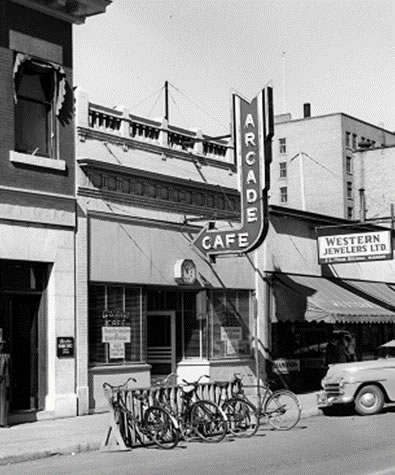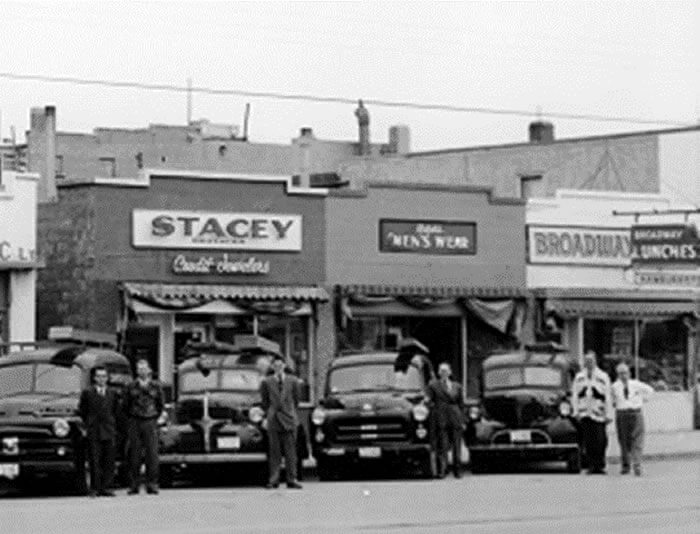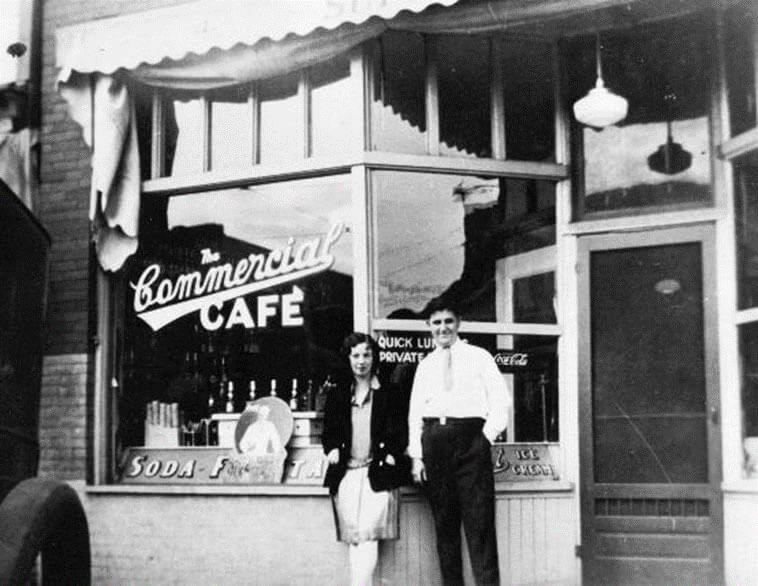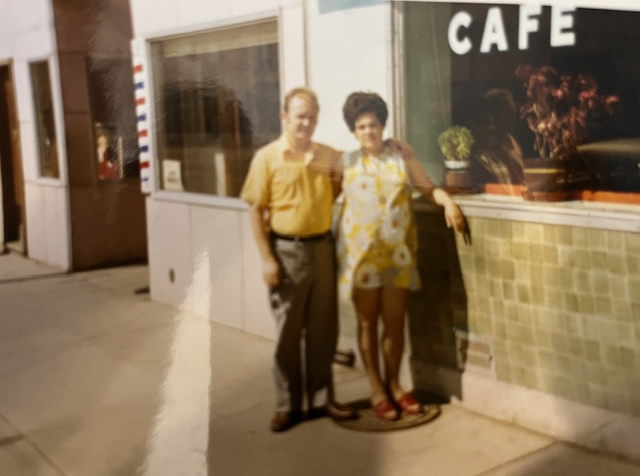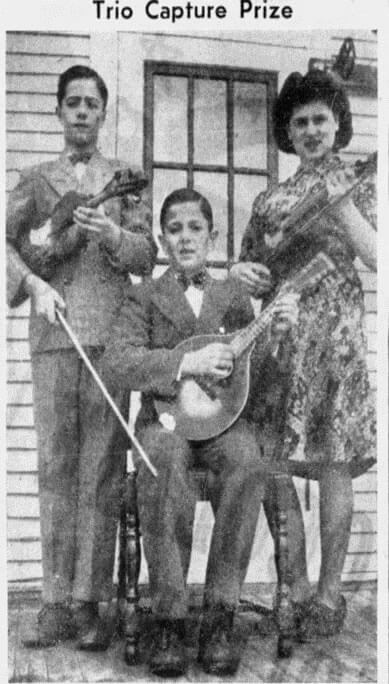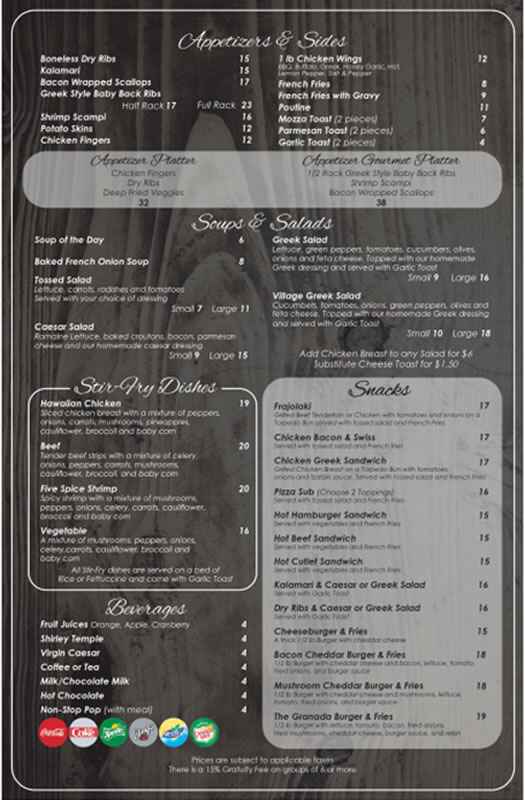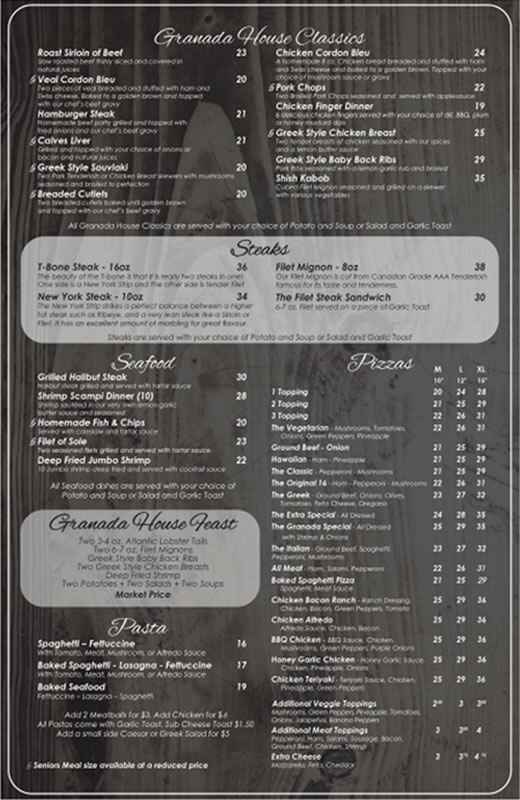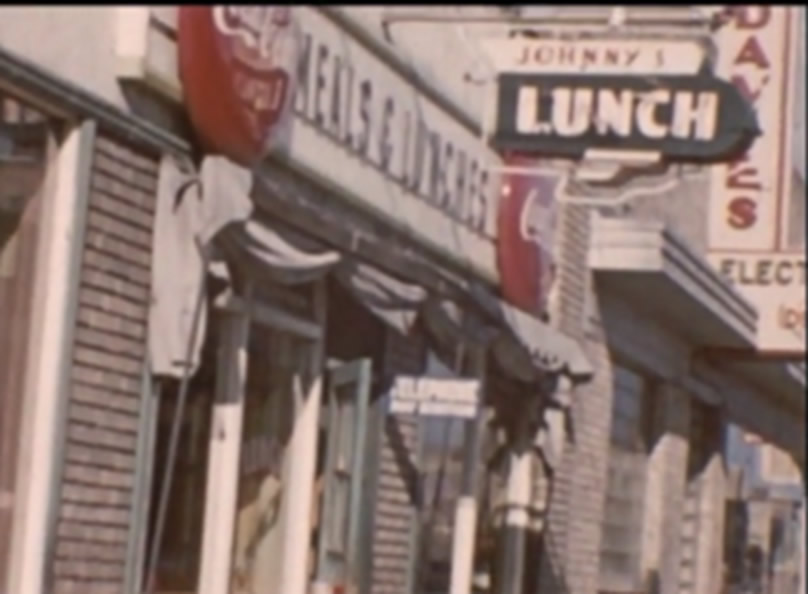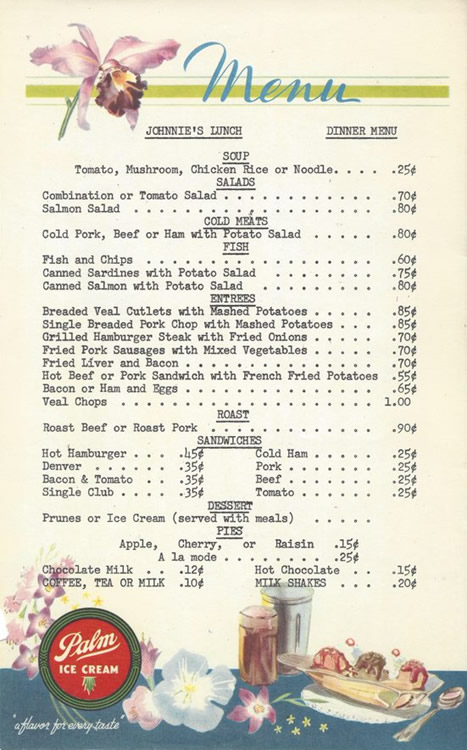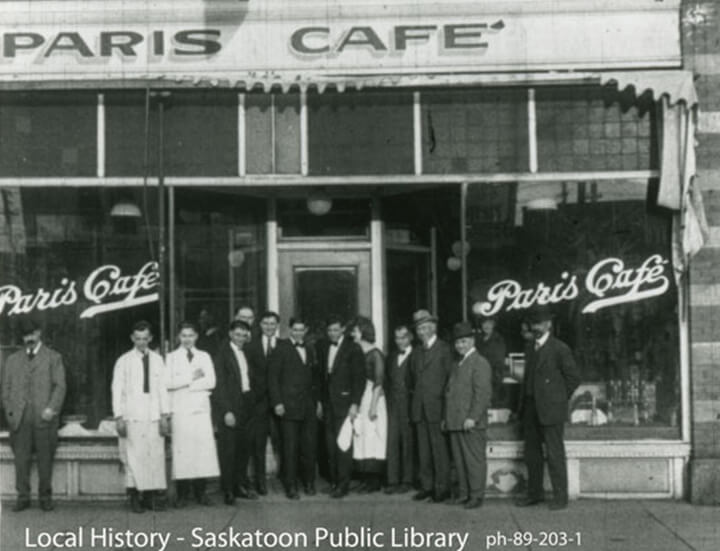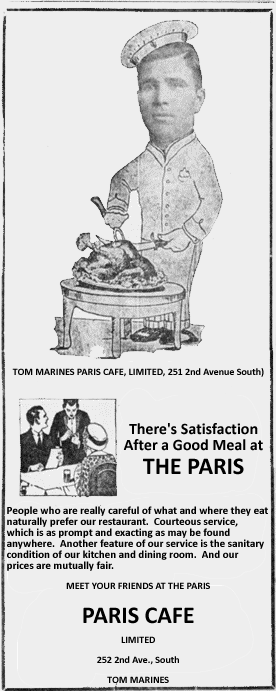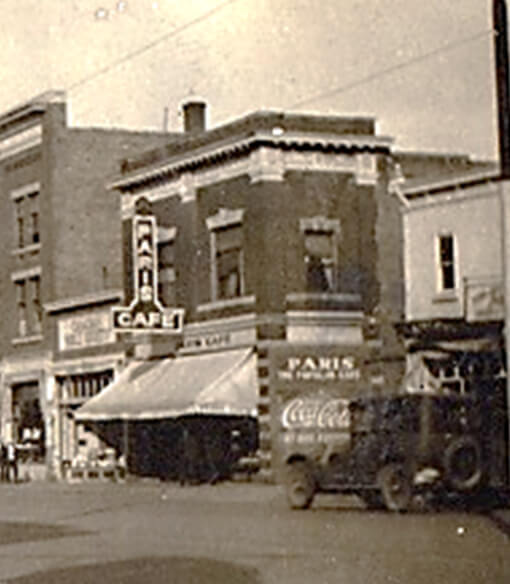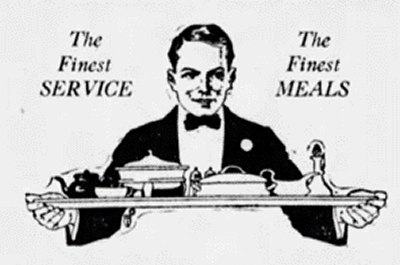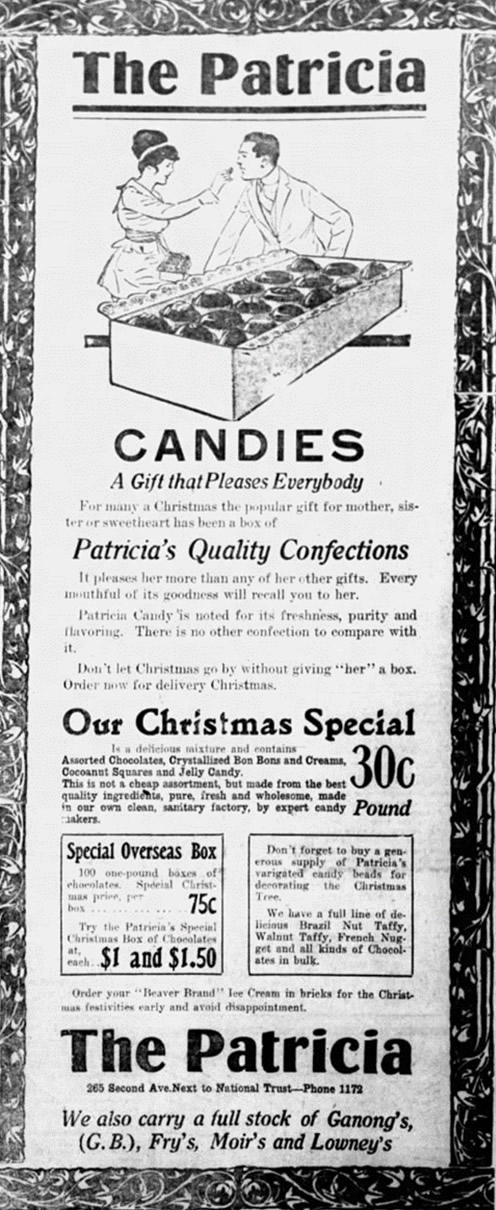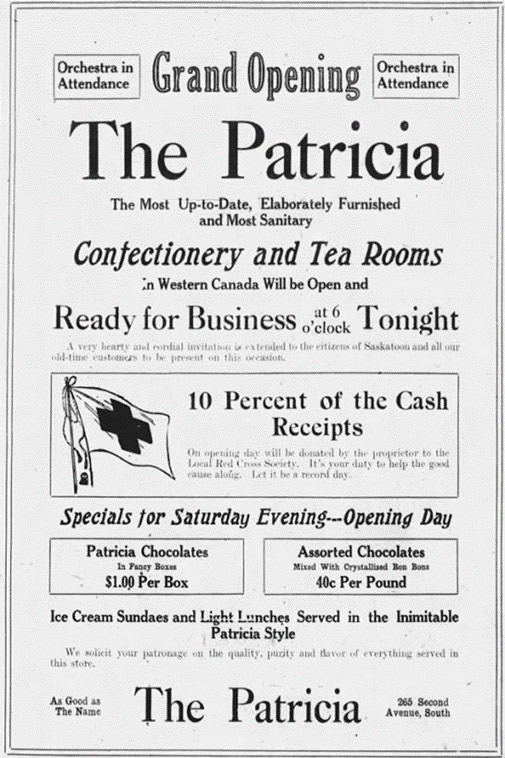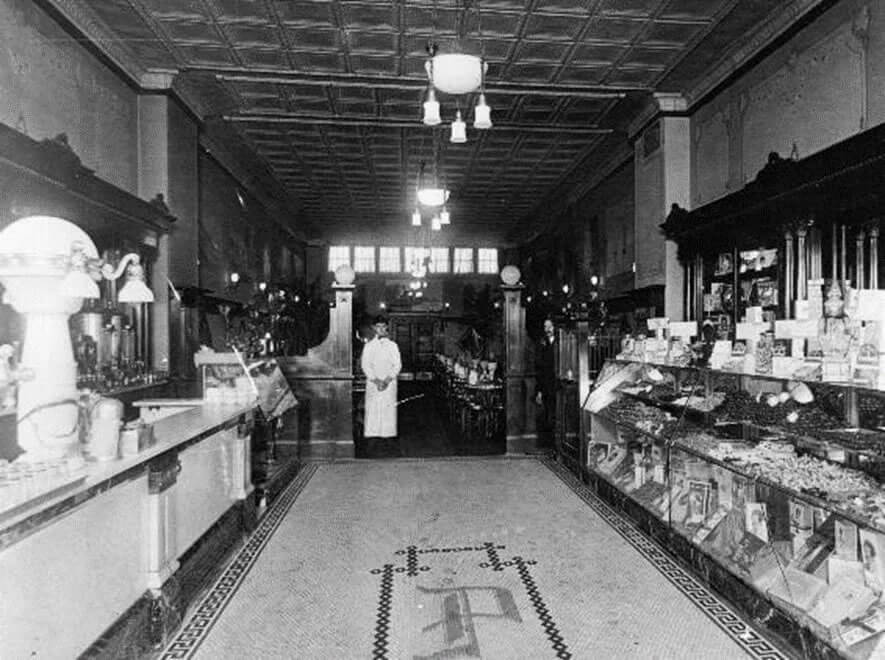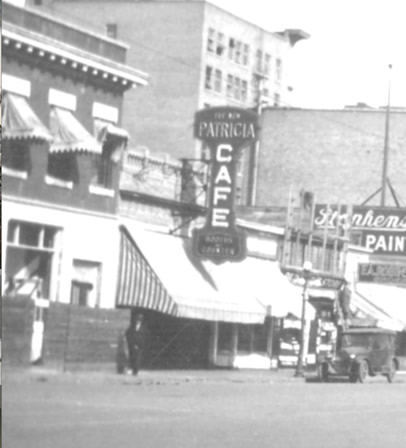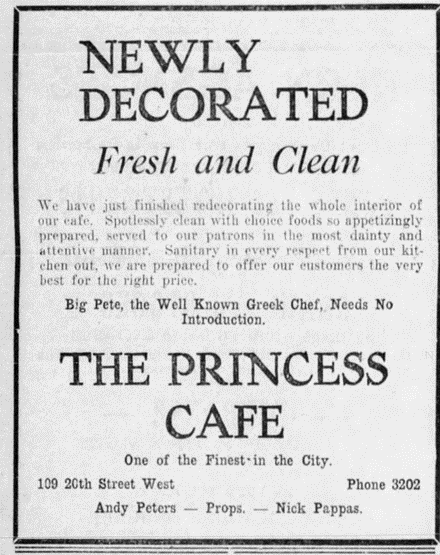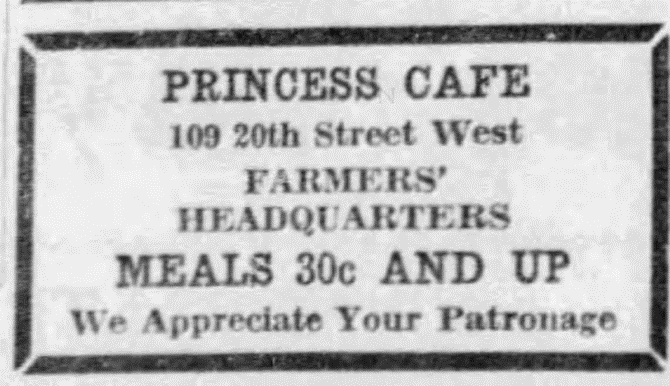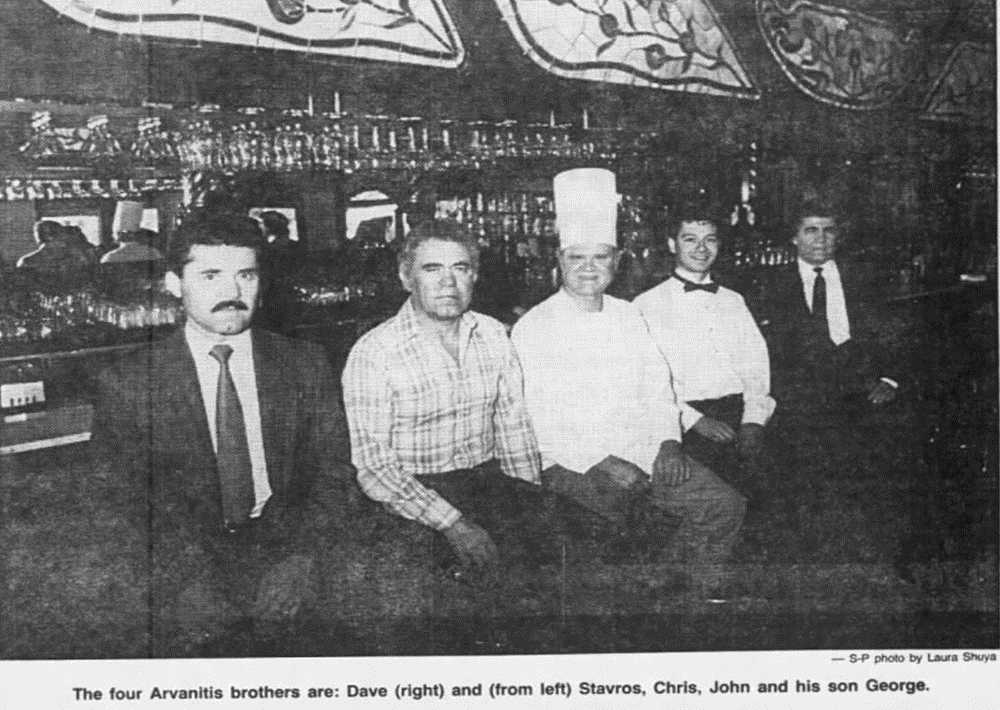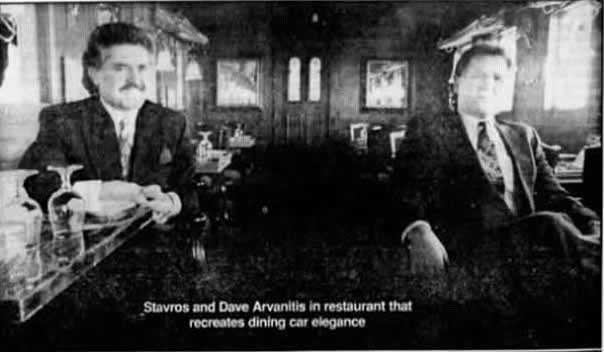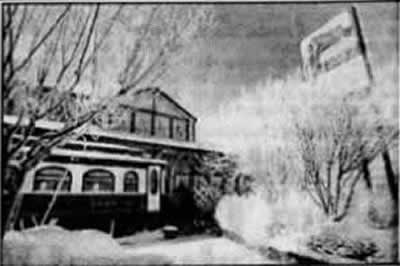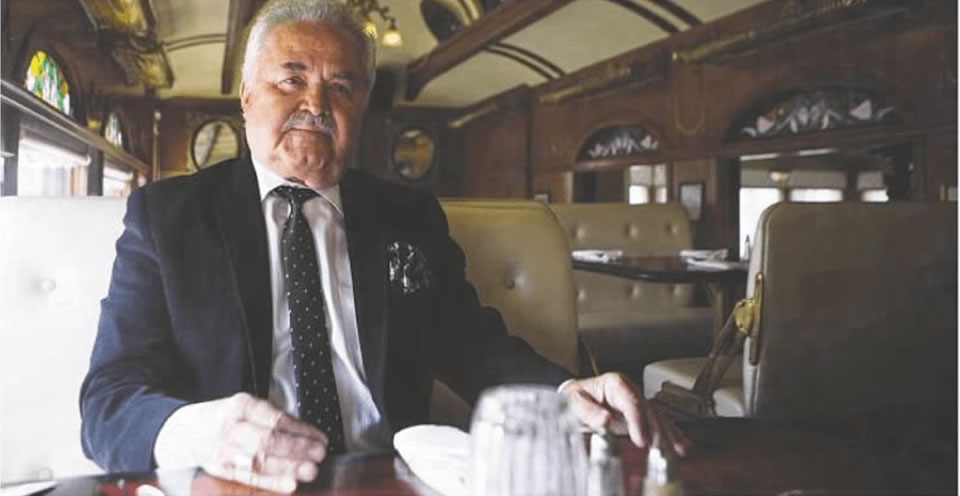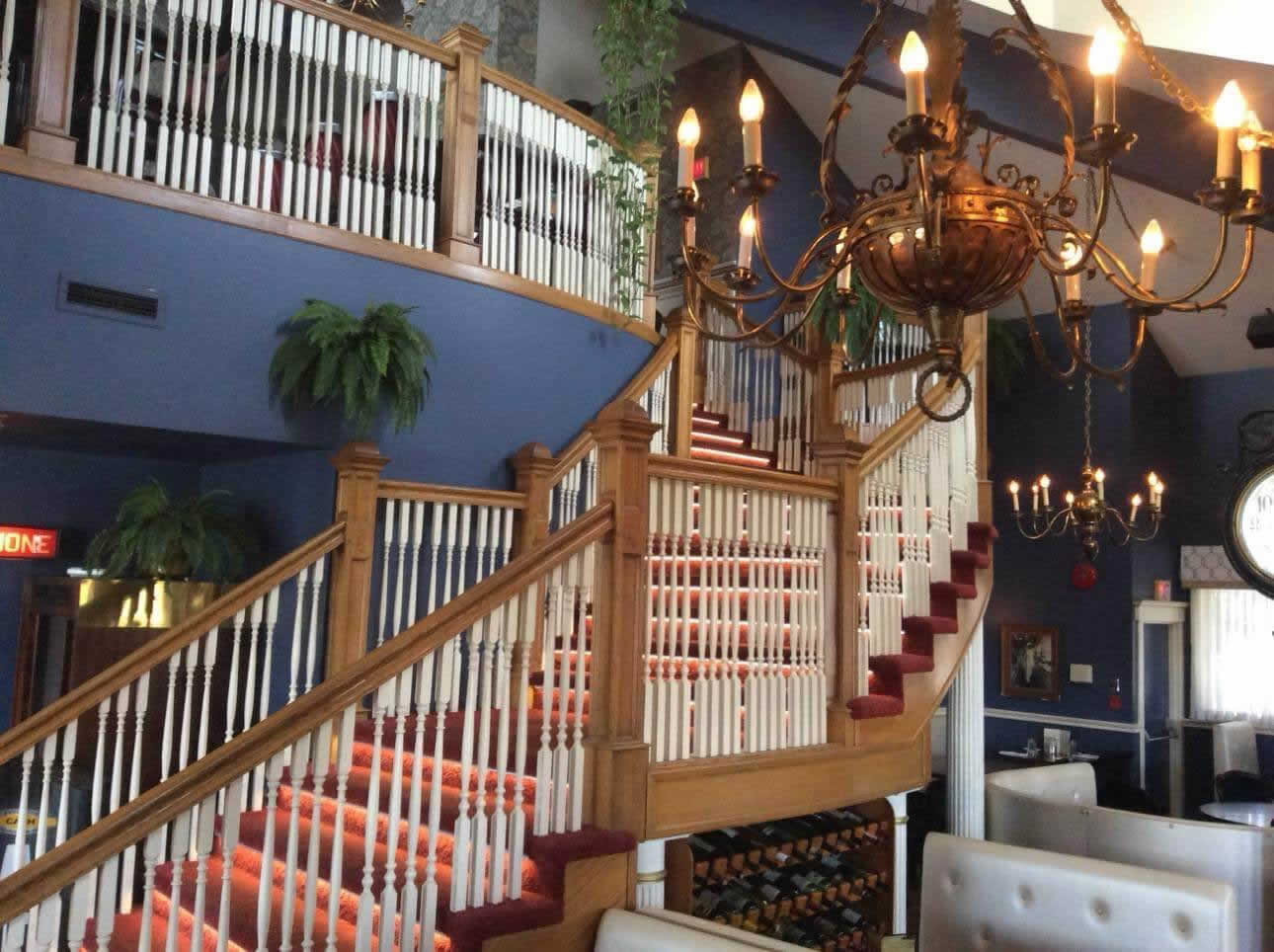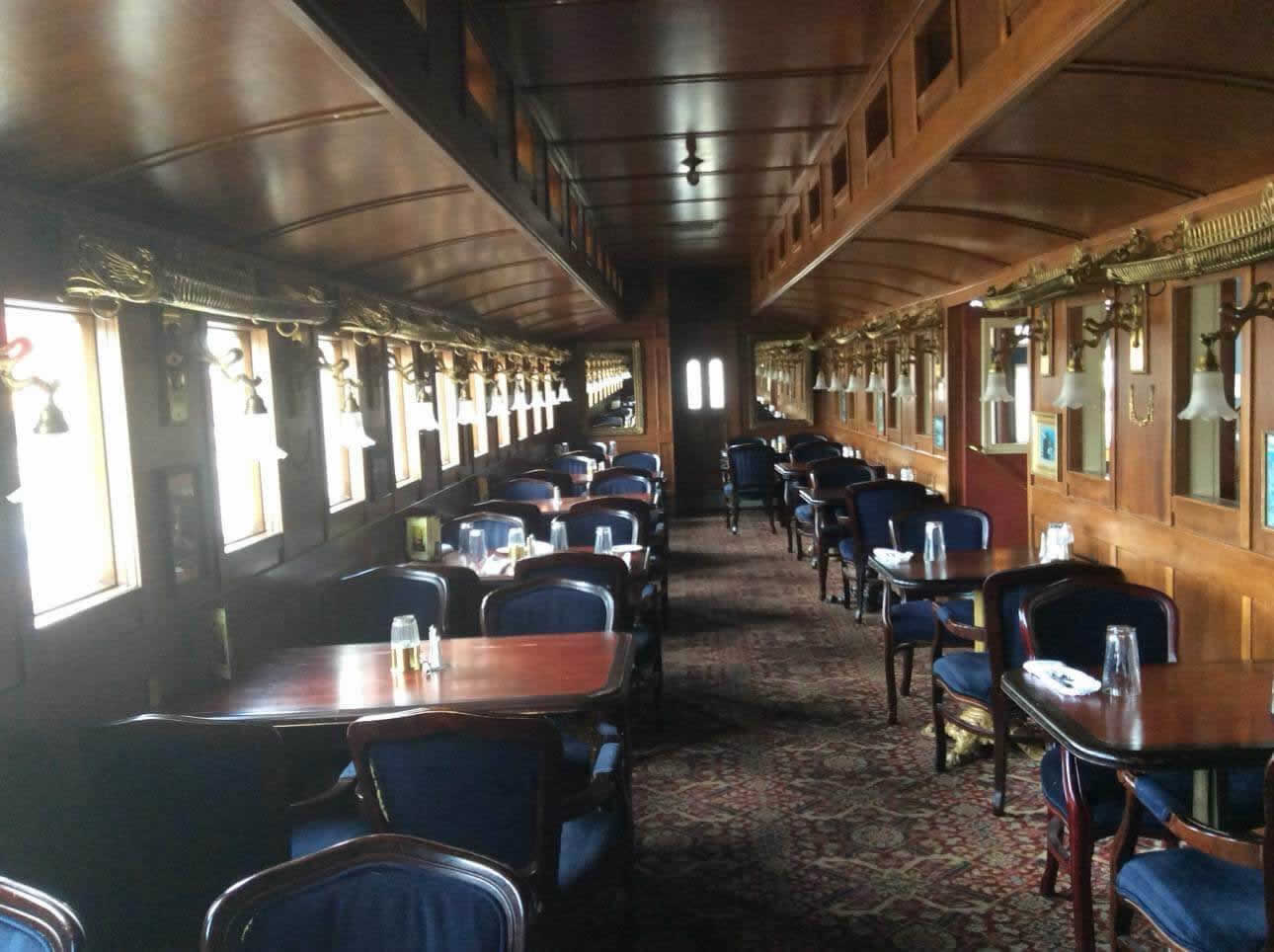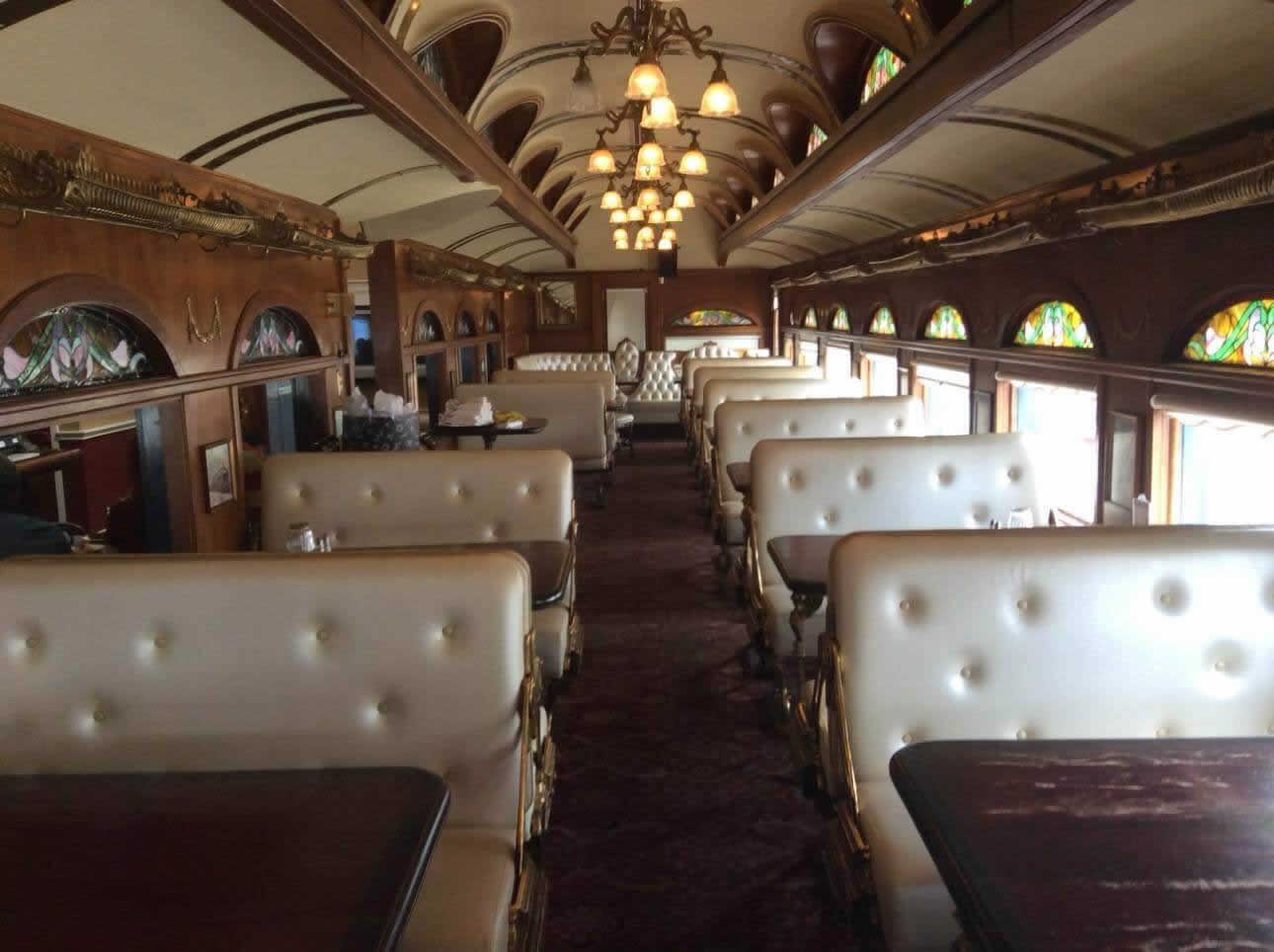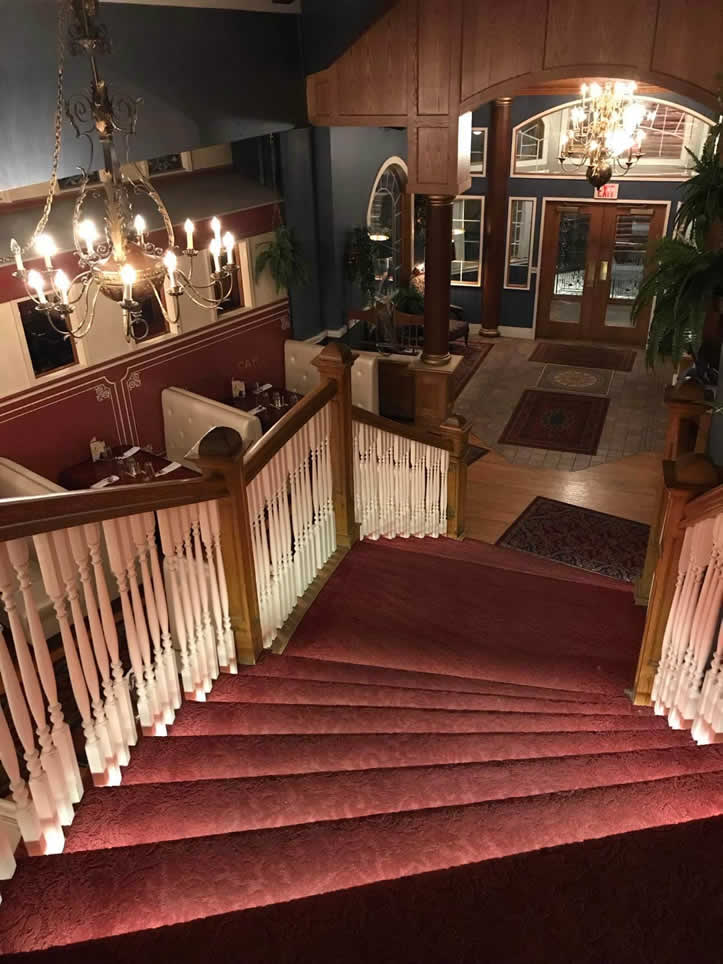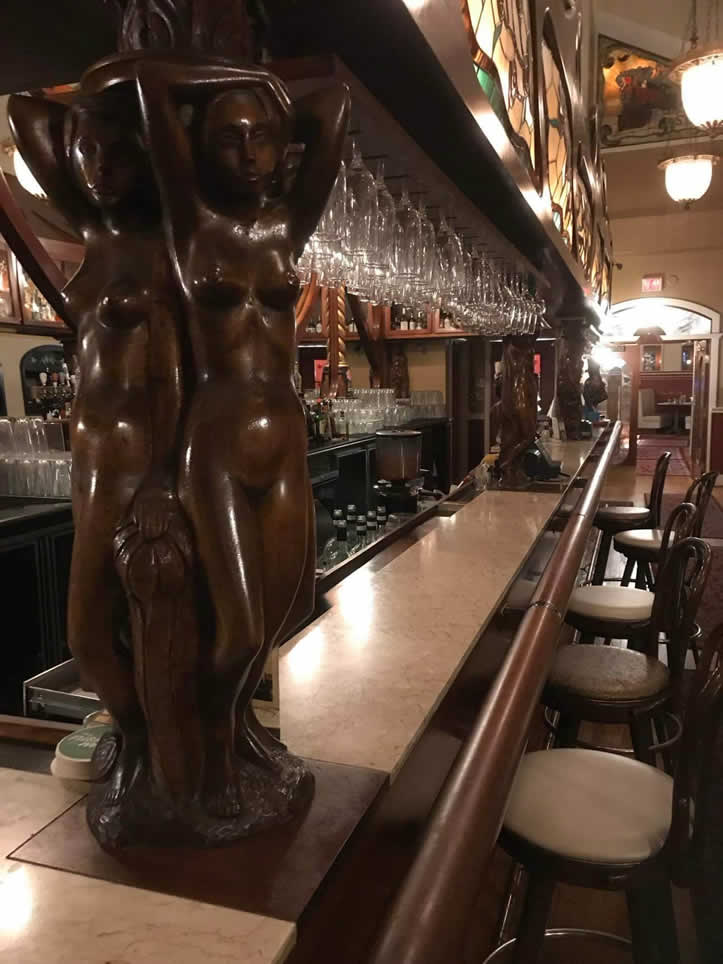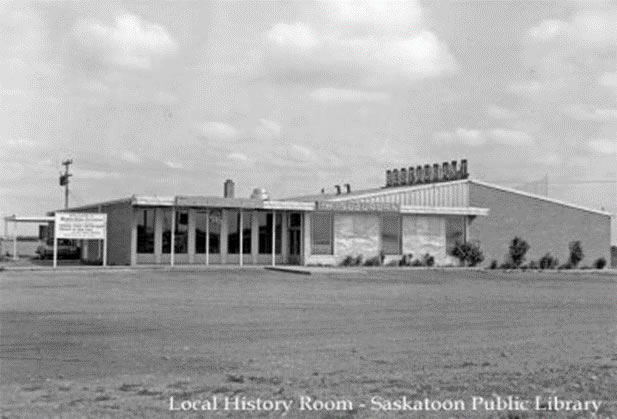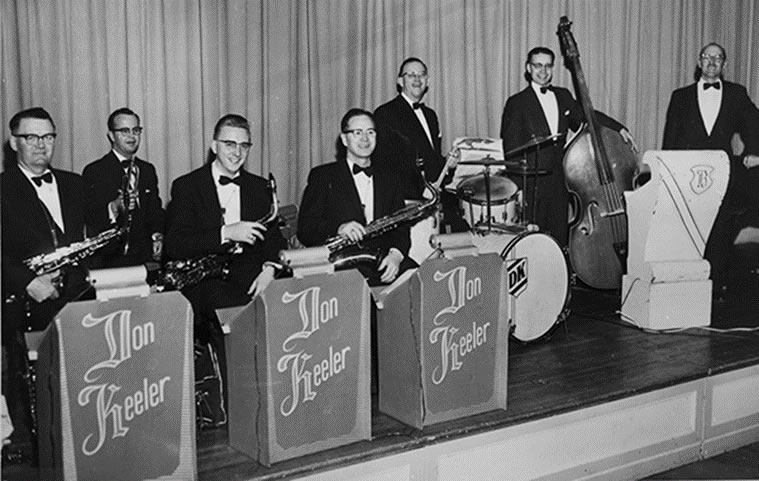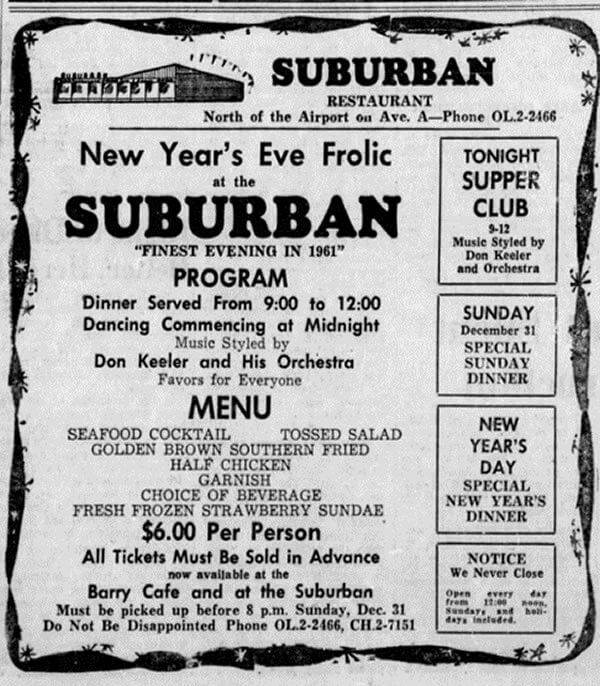Greek Restaurants
Many of Saskatoon’s earliest Greek restaurants started out as confectioneries and tea rooms. The core of their operations was producing and selling chocolates, candies, and pasteries which they sold to department stores and other retailers in the city and beyond. They soon were opening their own retail operations, in the form of tea rooms which often employed tea-cup readers. By the late 1920s and early 1930s, Greeks began converting their businesses or opening new business that included luncheonettes, coffee shops, cafes, and restaurants.
Tributes to Saskatoon's Greek Restaurants
Greek island once found in downtown Saskatoon

Damage is pegged at $1 million in the fire that gutted a downtown restaurant and a coffee shop last week. And the Greek artifact that was torched? Priceless.
The Commodore Cafe was heritage property, as distinctly Saskatoon as The Bessborough and the weir parking lot. Granted, the Commodore of late was different from how it once was; with a succession of owners in recent years the character of the joint had changed. But it was still The Commodore-same name, same place, a last link to a colourful chapter in the history of the city.
The cafe was there for 60 years, going back to when Steve Leakos set up shop on Second Avenue in 1947. The New Commodore, Leakos called it then, to distinguish it from the other Commodore he ran for 15 previous years at another downtown location, on 21st Street.
Aside from his experience with a railway labour crew in Alaska, restaurant work was the life for Leakos – from the time he left home in Kyparisi, Greece at age 14 until he retired in 1973.
Leakos came to Saskatoon in 1930, at a time when the local Greek community was just getting cooking. That’s the remarkable thing about The Commodore, because as much as the cafe tells a story of one family, you can multiply it times 10. Downtown Saskatoon back in the day wasn’t just The Commodore and Steve Leakos, it was The Gem Cafe run by Jim Chrones and it was Peter Pontikes at Johnny’s Lunch, and it was Tony Pelehos standing on the corner of 21st and Second with his Popcorn Palace cart. It was Gus Golf at Golf’s Chocolate Shop, too, and the Girgulis brothers at The Elite Cafe and the Gardiner brothers at the Shasta Cafe and Bill Geatros at the Ritz Hotel.
Most of them started out as busboys and dishwashers and worked their way up, setting out on their own when their sense of independence and the latent entrepreneurship kicked in. All of them ended up doing business within a few blocks of each other, some over the span of decades.
“It’s quite a story,” said Peter Golf, 77, Gus’s son. It’s Greek history, set in downtown Saskatoon. Jim Girgulis was one of the forerunners of the odyssey, leaving home at 15, selling popcorn and peanuts on Coney Island, eventually making his way to Saskatoon where he bought the Elite Cafe in 1919.
The Girgulis brothers – Jim, Bill and Sam – were from the village of Kastri, Greece, home also of Chrones and Geatros and Pontikes. Although they arrived at a common destination, settling in Saskatoon in the early 1930s, they took different ways of getting here.”
Chrones, for instance, came to Saskatoon at age 28 after 14 years of working 14-hour days at the Commercial Cafe in Weyburn. Pontikes took the direct route, leaving home at 19 following the death of his father and moving to Saskatoon to join his sister Effie and her husband, Bill Geatros, in running the Ritz Hotel and the Bijou Theatre. Pontikes sent much of the money he made in Saskatoon back to Kastri to support the rest of the family, a benevolence continuing throughout his life as Peter and his wife Lola sponsored Greek families who settled across Western Canada.
Each of the Second Avenue Greeks contributed to the city. Steve Leakos sponsored basketball and hockey and softball clubs in Saskatoon for 40 some years under the Commodore crest. Jim Gardiner’s Shasta Black Hawks won back-to-back provincial titles in women’s basketball. Geatros was a top gun at the trapshooting range, as was Jim Girgulis. Girgulis was noted for coaching Saskatoon’s George Genereux to Olympic gold in Helsinki in 1952; Geatros for the special dispensation he received from the city to hunt a flock of rogue pigeons.
Competition was inherent among the Greek restaurants. A story is told of how the owner of one of the restaurants would often drop in at the cafe of another in the morning – to visit, yes – but mostly to note the number of pies in the glass display cabinet, so when he stopped by again later in the day and did another pie count, he’d know how the neighbour’s business was going. They were competitive, but fraternal, too. Each evening after work, the group of them got together at the Ahepa Club on 20th Street to play poker and have some laughs.
Peter Golf started out in the business as his father did, beginning young. At 15, Peter was a tray boy at Golf’s Chocolate Shop, not only working in the place, but watching and learning how a restaurant ran. By his 20s, Peter was an owner. He went on to own the Dog ‘n’ Suds drive-in and Bartlebys in Regina and Fuddruckers throughout Western Canada. At 77, Peter is at it still, now in his 54th year as a restaurant owner.
Peter’s first place was a burger joint with a neon sign out front shaped in the silhouette of a bird. One of his neighbours was a restaurant/banquet hall run by Jack Chrones, Jim’s son. The second generation of Greeks in Saskatoon had inherited a vision and entrepreneurship from the first.
This was the 1950s. And that was 8th Street. With Peter Golf’s Nite Hawk and Jack Chrones’s Jaydees leading the way, the strip was about to get cooking.
Source: Saskatoon Star-Phoenix, December 10, 2017, p. 3
Arcade Cafe
Arcade Café
265 Second Avenue South
Owners/Operators: Chris, Tom, and Louis Kelles and Jim Stevenson (1942 – 1948); Jim Boulis, Nick Cassios, and Ted Soromokos (1948 – 1950)
This cafe opened in 1942 and occupied the space which previously housed the Patricia Cafe. The Arcade Cafe was operated by Tom, Chris, and Louis Kelles (Kelesides) and Mr.Jim Stevenson (Stavropoulos). They had been operating concessions for the previous 14 years at Crystal Beach, near Harris SK.
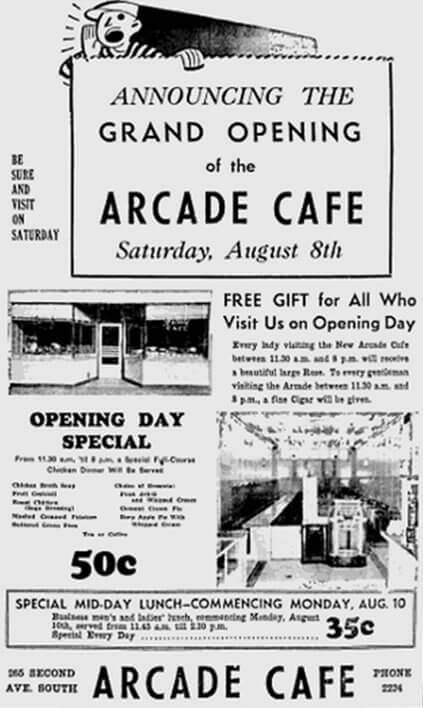
Source: Saskatoon Star-Phoenix, June 8, 1949, p. 6.
Photo Source: Arcade Café (1948 or 1949)
On opening day, the Saskatoon Star-Phoenix described the interior of the cafe:
“Spick and span in its renovated colors and equipment, the new Arcade Café presents an inviting atmosphere of cleanliness. The dining room has eight booths, each leather-backed and with smart pastel-colored tables as well as an open area of nine other tables. A 25-stool lunch counter, equipped with leather-covered stools trimmed with chromium, runs about three-quarters of the length of the building. There are sanitary washrooms on the main floor. Hot water always is provided.
A modern soda fountain and ice cream bar is another innovation.
The kitchen has modern facilities, including a refrigerator room for all perishable stock. The lighting fixtures are indirect-type chandeliers. Air-cooling facilities are also numbered among the conveniences installed for the patrons of The Arcade.
The cafe will also cater to the public with daily supplies of fresh fruits, considerably of the front premises having been given over to these purposes and attractively displayed. Some candles and boxed chocolates as well as a full line of tobaccos are purveyed from in-display cases.” (Saskatoon Star-Phoenix, August 7, 1942, p.5.)
Tom Kelles was described as the cafe’s “congenial manager” who was “very popular with the public and his pleasing manner and friendliness [made] the Arcade a popular eating place” (Saskatoon Star-Phoenix, March 9, 1946).
In November 1948, ownership of the Arcade Cafe had passed to Jim Boulis and Nick Cassios (and Ted Soromokos) who were described as “experienced restaurant men with years of service in the business . . . .” (Saskatoon Star-Phoenix, April 22, 1950). They operated the Arcade Café until October 1950 when the business was sold to operators who were not members of the Greek community.
Researched by: Ken Pontikes, October 31, 2023.
Broadway Lunch
Broadway Luncheonette/Broadway Lunch
826 Broadway Avenue and 710 Broadway Avenue
Owner/operator: Agellos George (“Charlie”) Kallops (1938 – 1954)
Agellos Kallops previously owned the Golden Gate Cafe and Confectionary. In 1935, he moved to Prince Albert and returned in 1938 to open the Broadway Luncheonette, which he renamed in 1949 as the Broadway Lunch. He died in 1954.
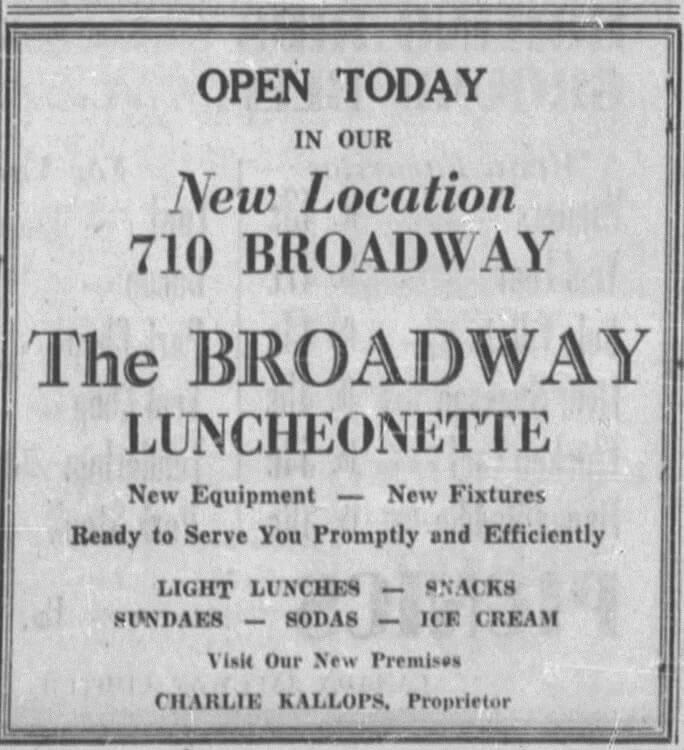 Source: Saskatoon Star-Phoenix, June 8, 1949, p. 6.
Source: Saskatoon Star-Phoenix, June 8, 1949, p. 6.
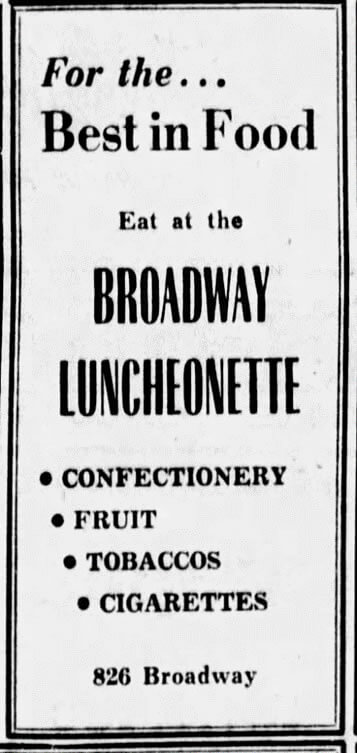
Source: Saskatoon Star-Phoenix, October 11, 1946, p. 6.
Broadway Lunch (early 1950s)
Source: Saskatoon Public Library, Local History Room (PH-97-30-10)
Researched by Ken Pontikes, December 14, 2023
Commercial Cafe
Commercial Café
118 – 20th Street West
Owners: George Karabelis and George Chitsas (1928 – 1949); George Karabelis (1949 – 1962); Speros J. Kokonas and Nikitas (Nick) S. Kokonas (1962 – possibly 1969); and George Antonopoulos and Alex Liakopoulos (1969 – 1973)
George Karabelis came to Canada in 1911. He operated businesses in Weyburn and later in Chicago. He moved to Saskatoon in 1928 when he bought the Commercial Cafe. He operated the Commercial Cafe in partnership with George Chitsas and then on his own following Mr. Chitsas’s death in October 1949.
George Karabelis and his wife, Madge, are standing in front of the Commercial Cafe (1929)
Source: Saskatoon Public Library, Local History Room (LH-6002)
Shirley and Alex Liakopoulos were a Greek family that would buy into the Commercial Cafe as the years passed by.

Saskatoon Star-Phoenix, April 30, 1932, p. 16.
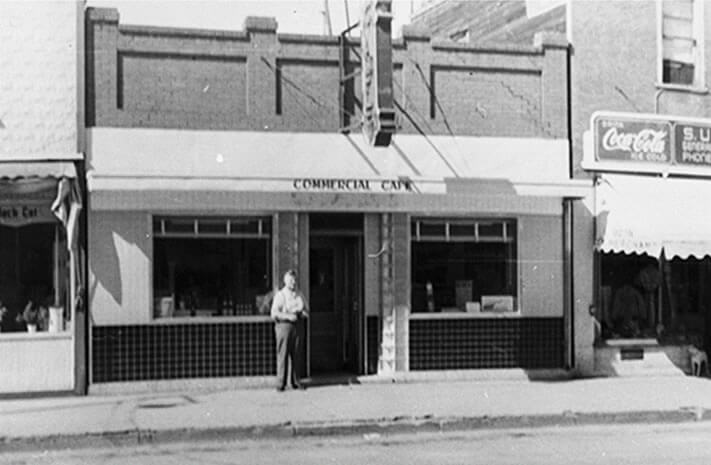
George Karabelis standing in front of the Commercial Café (1949)
Source: Saskatoon Public Library, Local History Room (LH-6023)
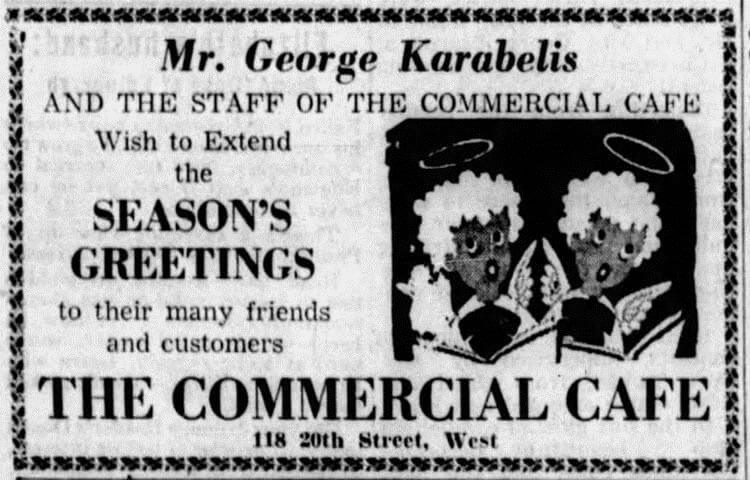
Saskatoon Star-Phoenix, December 24, 1951, p. 7.
Following George Karabelis ‘s death in 1962, the Commercial Café was operated by Speros J. Kokonas and Nikitas (Nick) S. Kokonas and later by George Antonopoulos and Alex Liakopoulos.
Researched by Ken Pontikes, September 28, 2023
Sources: Saskatoon Star-Phoenix, June 27, 1951, p. 10 and September 16, 1969, p. 17.
Commodore Cafe
Commodore /New Commodore Café
134 – 21st Street East and 108 Second Avenue North
Owners (Commodore /New Commodore): Nick Giokas and Gust Nantsos (1926 – 1929), Harry Terzakis and Nick Lappas (1929 – 1932), Steve Leakos and subsequently Spero Leakos (1932 – 1972), Nikitas (Nick) Kokonas and Alex Liakopoulos (1972 – 1980), and several subsequent owners.
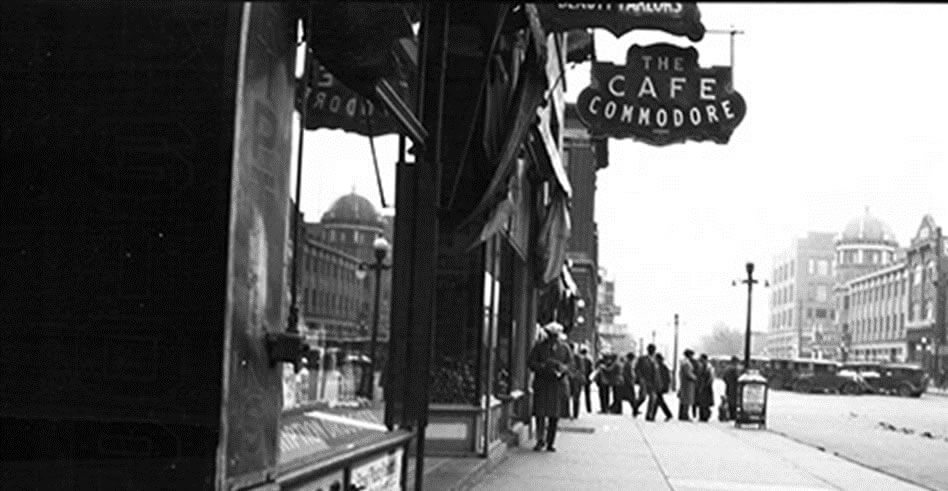
Commodore Café, located in the Bowerman Block on 21st Street between 1st and 2nd Avenue, ca 1929
Source: Saskatoon Public Library, Local History Room (PH-88-970)
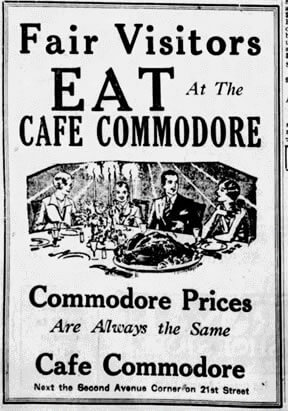
Saskatoon Star-Phoenix, July 15, 1930, p. 26.
Steve Leakos emigrated to the United from Greece in 1906. He was employed building railways in Alaska and then entered the restaurant industry in San Fransisco. Subsequently, in 1923, he lived in Vancouver where he married is wife, Agatha Kortes. Steve and his family moved to Moose Jaw in 1927 to help in a business started by Agata’s brothers. In 1932, Steve moved with his family to Saskatoon to take over the operation of the Commodore Café.
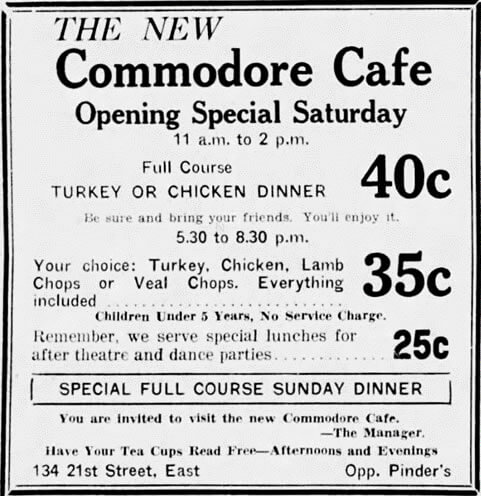
Saskatoon Star-Phoenix, November 4, 1932, p. 22
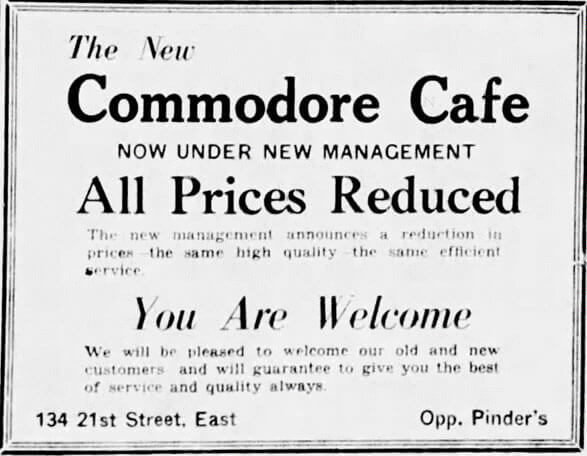
Saskatoon Star-Phoenix, November 3, 1932, p. 11.
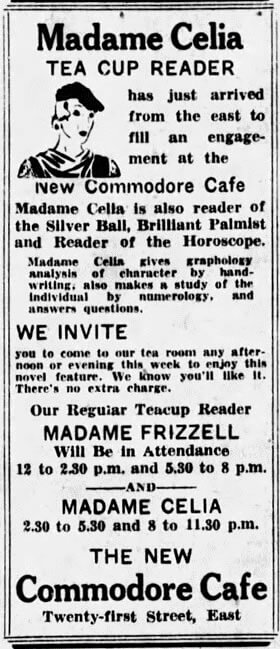
Saskatoon Star-Phoenix, January 24, 1934, p. 8
Steve Leakos’ three children – Evangeline, Spero, and James – formed the Leakos Trio and performed frequently at the Commodore Cafe. They won first prize in 1940 at an amateur night sponsored by the Saskatoon Lodge of the International Order of Foresters (I.O.O.F). For a while, they were the featured entertainment during Sunday evening dinners at the Café.
THE three children of Mr. and Mrs. S. Leakos of 328 Eighth Street, Saskatoon, Evangeline, Spero and Jimmy, have become known as an accomplished instrumental trio. They won first prize at Premiere Amateur Night of the Saskatoon Lodge of the 1.0.0.F. recently.
Saskatoon Star-Phoenix, March 13, 1940, p. 6.
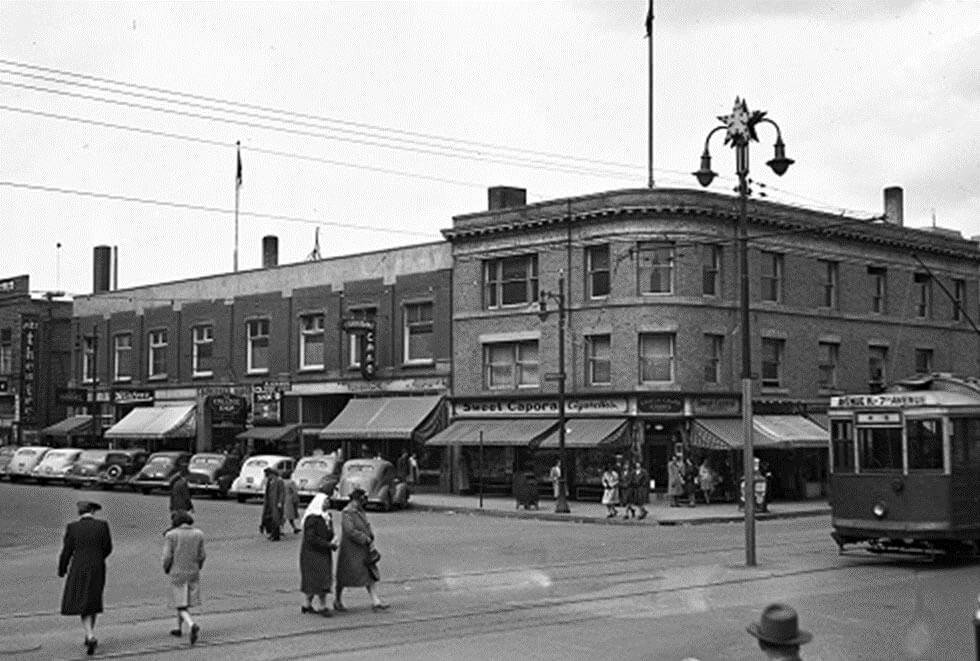
Commodore Café, located in the Bowerman Block on 21st Street between 1st and 2nd Avenue, ca 1940
Source: Saskatoon Public Library, Local History Room (B-136)
On December 24, 1945, the Commodore Cafe relocated from the Bowerman Block on Twenty-first Street East to a Second Avenue North location. A formal grand opening was delayed until March 1946. The new location involved alterations and an addition (to accommodate the kitchen) to an existing building.
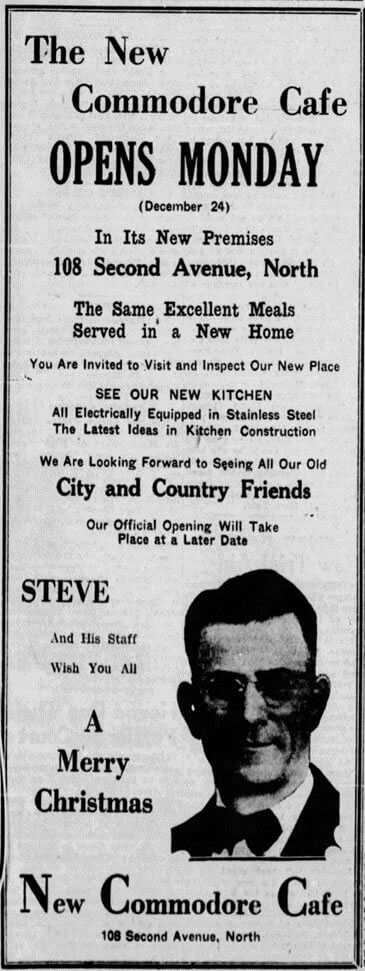
Saskatoon Star-Phoenix, December 22, 1945, p. 5.
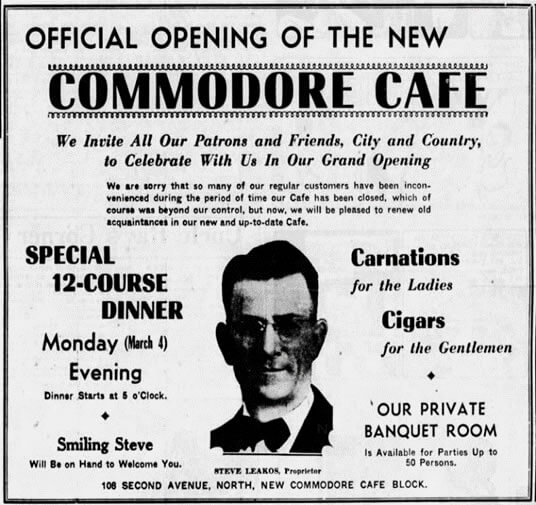
Saskatoon Star-Phoenix, March 4, 1946, p. 11.
In 1950, the café underwent a renovation, including “Formica counters and table tops, tables with chrome legs, arborite panels, seats and stools covered with beautiful leather, counter cases and back bar made of solid oak” (Saskatoon Star-Phoenix, November 10, 1950, p. 21). In 1956, the cafe at the Second Avenue location added a banquet room known as the Corvette Room.
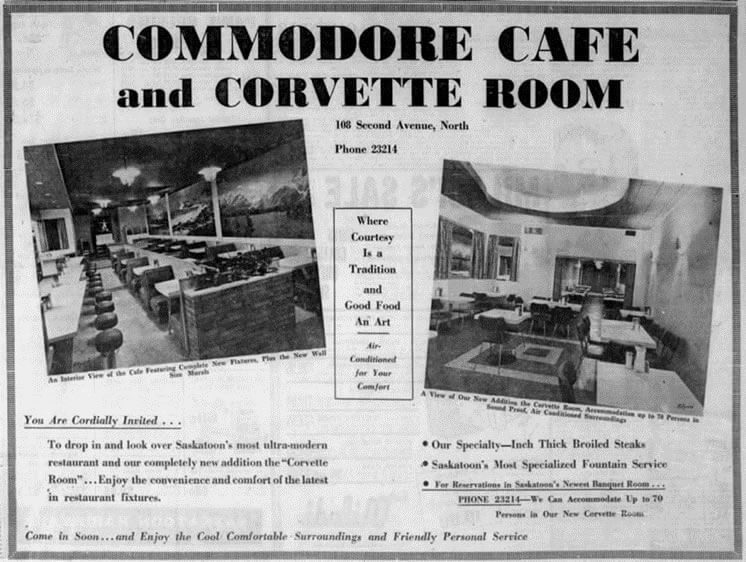
Saskatoon Star-Phoenix, July 6, 1956, p. 10
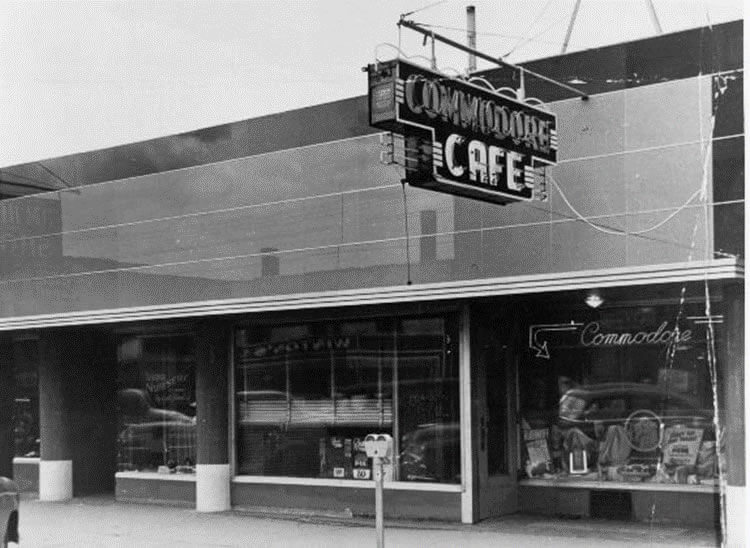
Commodore Café, 108 Second Avenue South location (1952)
Source: Hillyard Photographs Collection, Saskatoon Public Library (B-8700)
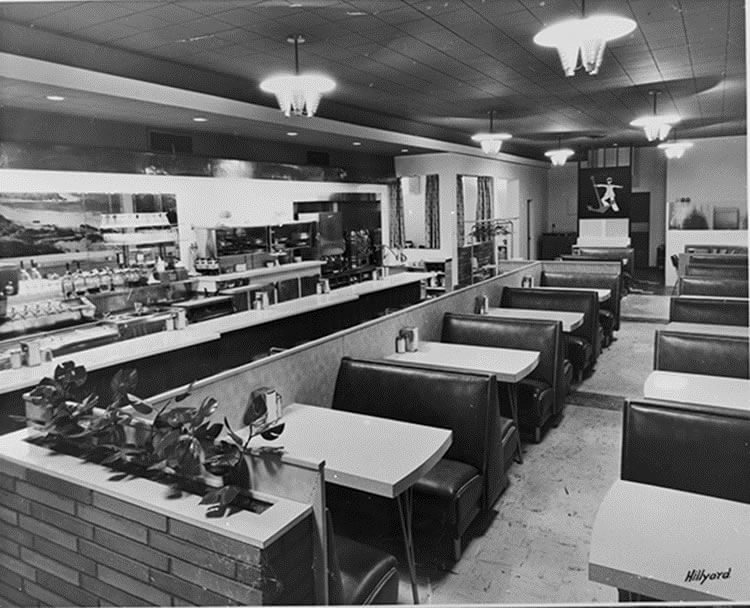
Commodore Café, 108 Second Avenue North (1968)
Source: Saskatoon Public Library, Local History Room (LH-6076)
Throughout their operation of a café in both locations in downtown Saskatoon, the Leakos Family and the Commodore Café were responsible many sports sponsorships and the nurturing of many young athletes in Saskatoon. Most notable was the family’s administrative involvement with the Saskatoon Gems baseball team which evolved into the family’s ownership of the Saskatoon Commodore’s semi-pro baseball team. However, the family’s support also extended to include the local hockey, basketball, and soccer communities.
Nikitas Kokonas and Alex Liakopoulos purchased the Commodore Cafe in February 1973. The Leakos family sold the Commodore after forty-one years of continuous ownership and operation. The new owners renovated the café in 1975.
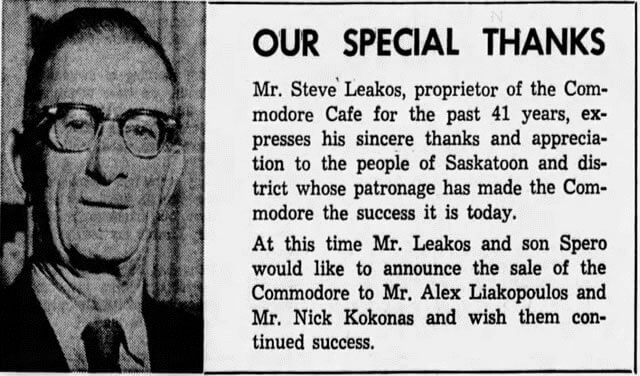
Saskatoon Star-Phoenix, February 3, 1973, p. 4.
In 1980, Nikitas and Alex sold their interest in this business and entered into a partnership with Bill Kondos and George Kondos in the Granada House Restaurant (904 – 22nd Street West).
Researched by Ken Pontikes, September 24, 2023
Sources: Saskatoon Star-Phoenix, May 15, 1930, p. 6; May 28, 1932, p. 3; April 22, 1945, p. 3; December 22, 1945, p. 5; and July 15, 1975, p. 10; Ned Powers, “Spero Leakos”, Saskatoon: The Powers Interviews (Saskatoon: Thistledown Press, 2006, pp. 79 – 83.
Elite Café
Elite Café
246 Second Avenue South (1917 – 1939)
224 Second Avenue South (1939 – 1971)
Owners/Operators: Sam Serif (1917 – 1919); William K. Shourounes, Tony Varves, and James Gourgoules (Girgulis) plus William H. Gourgoules, Tom Varve, and James Pontikes (1919 – 1922); Willam H. Girgulis and James H. Girgulis plus Sam H. Girgulis (1922 – 1971)
Owners (Commodore /New Commodore): Nick Giokas and Gust Nantsos (1926 – 1929), Harry Terzakis and Nick Lappas (1929 – 1932), Steve Leakos and subsequently Spero Leakos (1932 – 1972), Nikitas (Nick) Kokonas and Alex Liakopoulos (1972 – 1980), and several subsequent owners.
The Elite Café opened in June 1917 at its first location in the Kerr Block (246 Second Avenue South) and was under the ownership of Sam Serif. In 1919, Sam sold the café to the owners of the Savoy Café Company, a partnership consisting of William K. Shourounes, Tony Varves (Varvistsoitis), and James Gourgoules (Girgulis). This partnership therefore operated two cafes at the same time – the Elite Café (on Second Avenue South) and the Savoy Café (on Twenty-first Street East).
The Elite Café occupied 1,900 square feet and employed a staff of 15. It had 13 booths, with a seating capacity of 52. The lunch counter could accommodate 22 customers.

Saskatoon Daily Star, March 8, 1919, p. 16.
By 1922, the ownership of the Savoy and Elite Café was reported to have expanded to six partners. Athanasios (“Tom”) Varves (who was Tony’s brother), William H. Gourgoules (who was James’ brother), and James Pontikis. In May of that year, the partnership was dissolved and the ownership of the two cafes was split. The Girgulis brothers became the sole owners of the Elite Café.
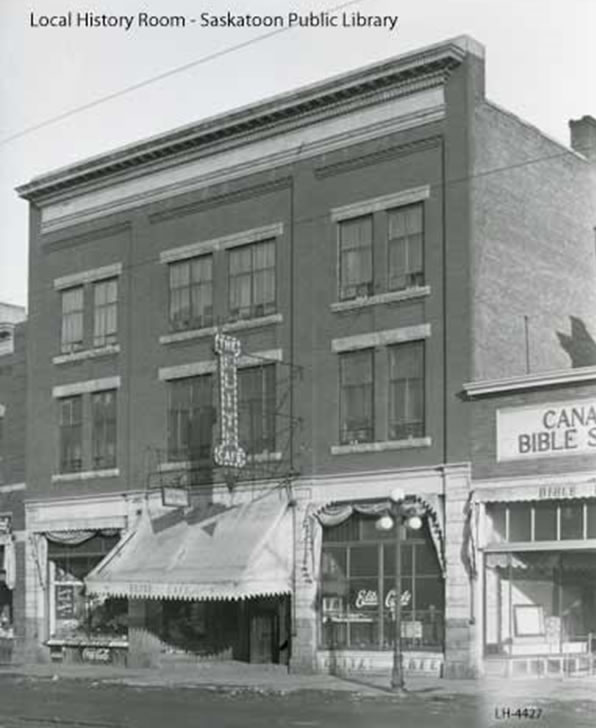
Elite Café (ca 1930), 246 Second Avenue South
Source: Saskatoon Public Library, Local History (LH-4427)
James and Williams’ younger brother, Sam, came to Saskatoon with their father in 1922. Sam worked his way into the business – from dish boy to head waiter – before joining the partnership.
In April 1931, suspicious fires in three locations on the second floor and a fourth in the basement of the building caused considerable damage to the Elite Café. While arson was suspected, police were unable to arrest anyone and an inquiry by the Fire Commissioner adjourned indefinitely without concluding the cause of the fires. After rebuilding from the fires, the Elite reopened in May 1931. To emphasize its around-the-clock operation, the Saskatoon Star-Phoenix reported that at 5:00 a.m. on May 23, 1931, William Girgulis (“restauranteur, golfer, hunter, and man of the world”) planned to “unlock the door of the Elite Café, rush down to the river, and throw the key into the Saskatchewan [River], while the early morning breakfast crowd flocks into its old and favorite stand” (Saskatoon Star-Phoenix, May 22, 1931, p. 3).
The renovated lunch counter was light and airy – the dark woodwork was replaced with mirrors and walls painted in creams, gold, and blue. The banquet hall was paneled in blue, cream, ivory, and brown.
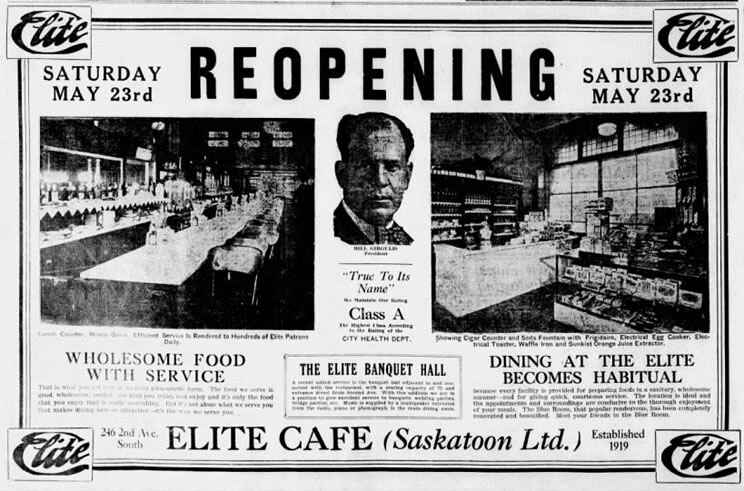
Saskatoon Star-Phoenix, May 22, 1931, p. 4.
The business prospered. It expanded to 9,425 square feet by 1935 and included two banquet rooms.
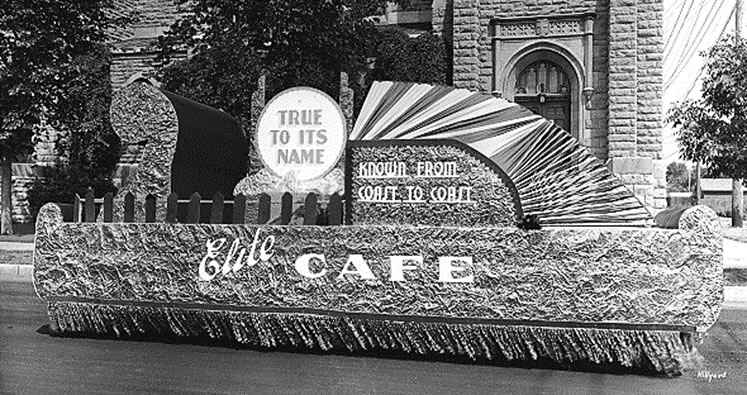
Elite Café parade float in the July 1938 Saskatoon Traveler’s Day Parade
Photo source: Saskatoon Public Library, Local History Room (A-427)
In December 1939, the Elite Café relocated to a newly constructed building at 224 Second Avenue South. The three Girgulis brothers leased the building from Dr. P. D. Stewart. (After the doctor died, the Girgulis brothers bought the property from the estate.) The building was air-conditioned and was able to filter and exchange air every ten minutes. The building was also one of the first in Saskatoon to install acoustic material to block sound between its rooms.
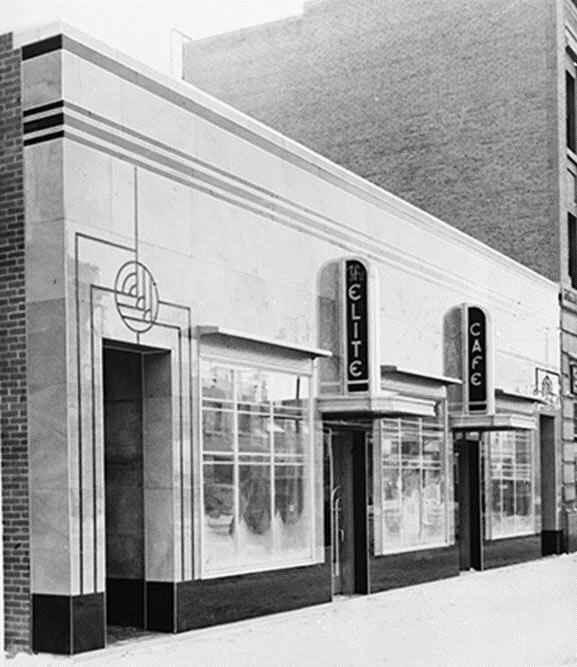
Elite Café (ca 1940), 224 Second Avenue South
Photo Source: Saskatoon Public Library, Local History Room (LH-6033)
The building was designed with the kitchen located centrally; separate serving exits led to the lunch room, dining room, and banquet room. A public lobby and cashiers’ desk was located between the separate entrances to the dining room (at the north end of the building) and the lunch counter (at the south end). The banquet room (“Blue Room”) extended across the entire back of the building; it could be accessed through the dining room or through a dedicated street entrance which led to the basement where coats could be checked and then to a red carpeted staircase to the main floor.
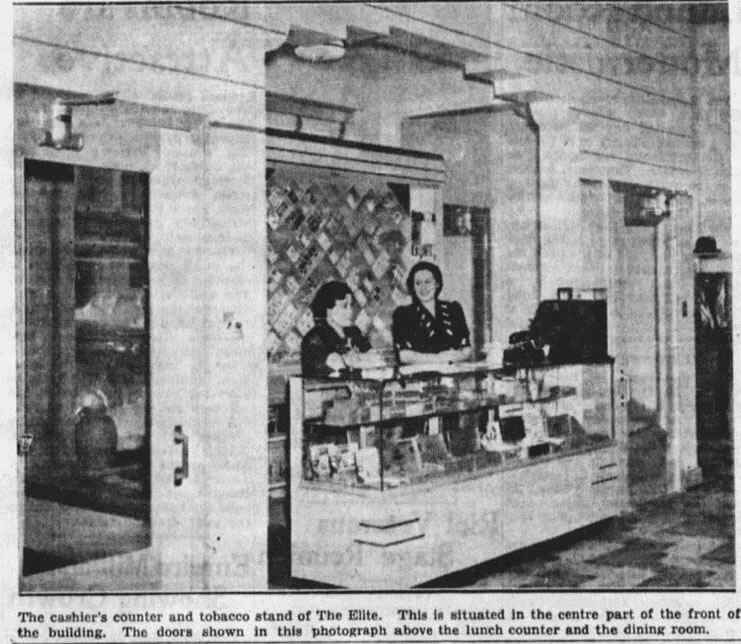
Saskatoon Star-Phoenix, January 13, 1939, p. 7.
The lunchroom had a seating capacity of 30 people. Red-topped Formica counters, mirrors and neon accent lighting, chrome chairs and light fixtures, and maple and walnut woodwork gave the room a contemporary look. The walls were painted in two shades of buff, separated by silver bands. The linoleum floor’s design was red, gray, black and white.
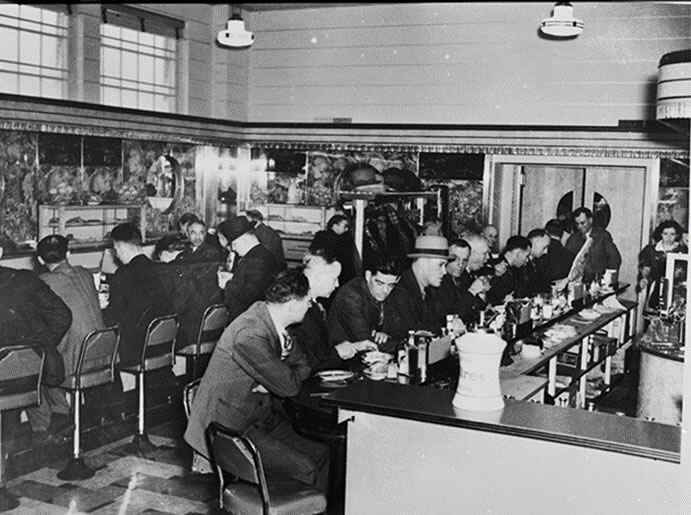
Lunchroom at the Elite Café
Saskatoon Public Library, Local History Room (LH-6034)
The dining room seated 104 people in booths accommodating two, four or six customers. The walls were painted in four shades of cream and buff. The partitions between the booths were made of maple and trimmed with walnut. Each table had a mirror, wall lamp, and “service buzzer” to call the serving staff. The seats were upholstered in red leather and the tables were topped with red and black sliver patterned Formica. The floor was the same as the lunchroom, but rugs were added to enhance the ambiance of the room.
The dining room featured prime rib of beef. White tablecloths covered the tables and the service included silver cutlery and finger bowls.
The Blue Room was decorated with layered wall panels in four shades of blue, separated by silver bands. The ceiling consisted of a cream-coloured acoustic board. Six windows, with Venetian blinds, were set high on the east wall. The floor was polished maple and ideal for dancing. The Elite became one of the first restaurants in Saskatoon to offer a dine-and-dance package. Instead of a live band or orchestra, recorded music was offered by a Wurlitzer.
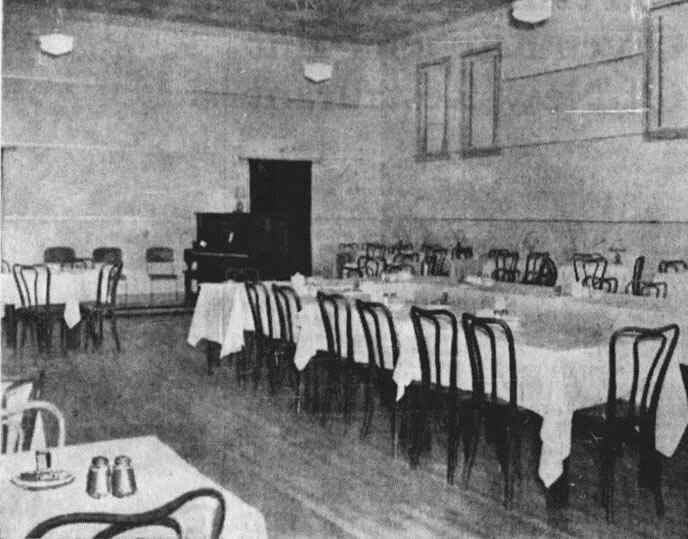
The Blue Room at the Elite Café
Saskatoon Star-Phoenix, January 13, 1939, p. 8.
The basement contained the building’s mechanical equipment and storage rooms, as well as an in-house laundry and employees’ dressing rooms and shower facilities.
With the outbreak of World War II, the Girgulis brothers incorporated patriotic themes in their newspaper advertisements. The Canadian Army’s recruitment center was in the basement of the Elite Café.
Labor shortages compelled the Elite to reduce its hours of business. In February 1942, the 24-hour operation was forced to close between 2:00 a.m. and 6:00 a.m. Then, in November of that year, the Elite agreed with other restaurants in Saskatoon to close one day a week.
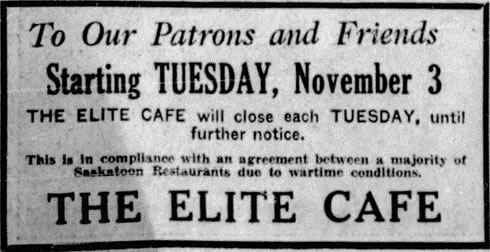
Saskatoon Star-Phoenix, November 2, 1942, p. 8.
In the 1950s the Elite Cafe was renovated in several stages. The lunchroom/coffee shop was the first to be redecorated. The dining room and the Blue Room were subsequently redecorated, A cocktail bar was added in response to changing liquor laws. By 1960, the exterior of the building facing Second Avenue was dramatically altered.
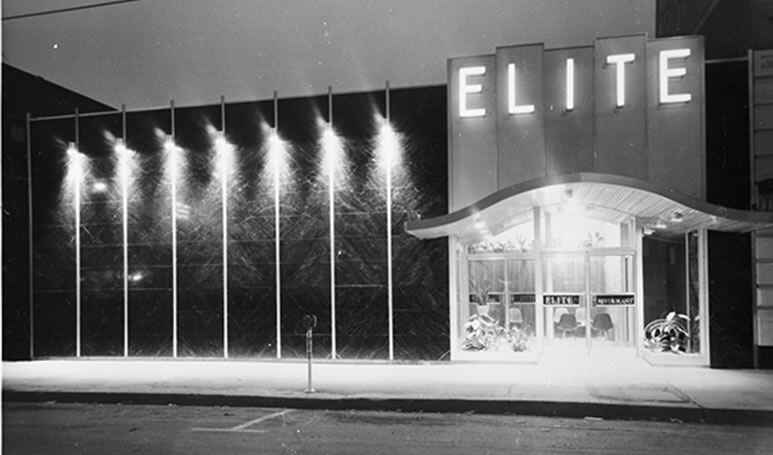
Elite Café (1960), 224 Second Avenue South
Photo Source: Saskatoon Public Library, Local History Room (LH-6075)
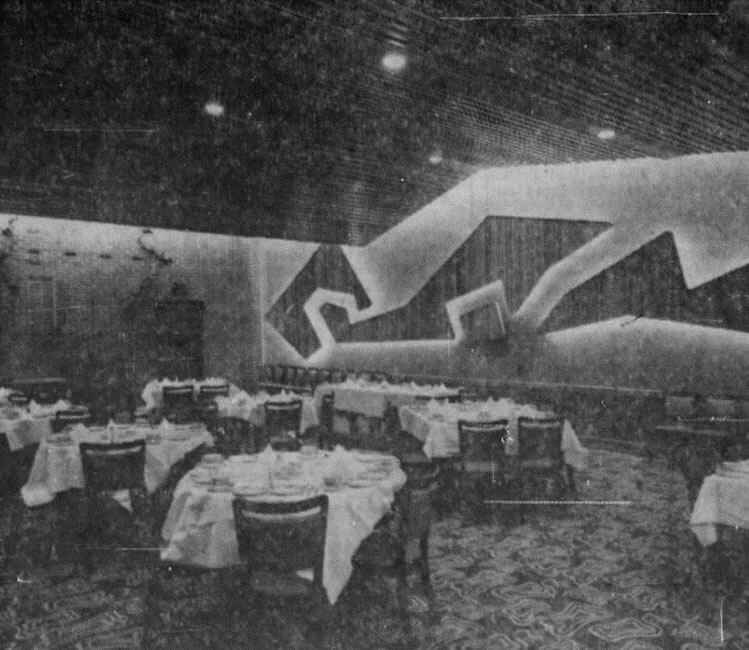
The Blue Room at the Elite Café
Saskatoon Star-Pheonix, January 25, 1957, p. 5.
The Girgulis brothers decided in 1971 to retire and therefore, close the Elite as a business, although they continued to own the property. The building subsequently was operated as nightclubs and restaurants, first by Y & D Yip Investment Ltd. and later by the Chicago Cattle Company. The latter closed its business, Outlaws Restaurant, due to financial difficulties in August 1982. Shortly afterward, a fire in the vacant restaurant severely damaged the building, as well as several adjacent properties. An employee of Outlaws Restaurant was subsequently charged and convicted of setting the fire.
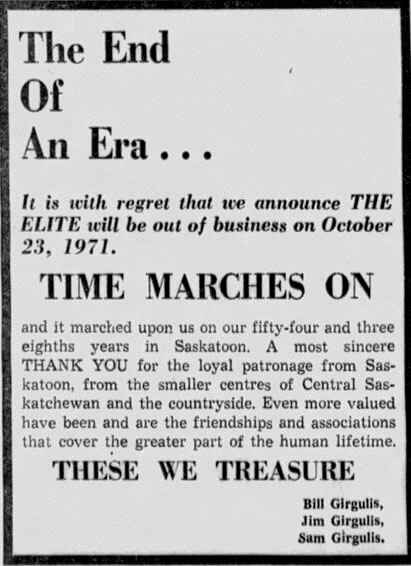
Saskatoon Star-Phoenix, October 20, 1971, p. 2.
The fire-damaged building was demolished in 1983. A cornerstone, containing mementos from the days when the building was constructed, was found and opened. The mementos included a newspaper a menu and engraved silverware from the Elite Café.
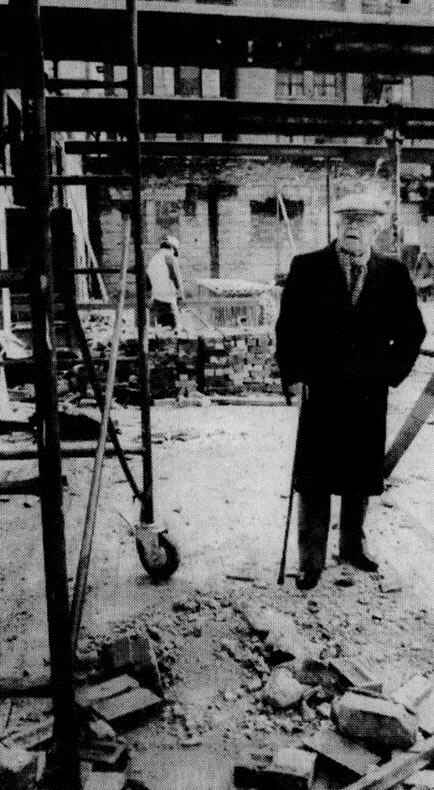
William Girgulis visits the site of the Elite Café as the building is being demolished.
Saskatoon Star-Phoenix, October 22, 1983, p. 41.
Researched by Ken Pontikes, April 10, 2024.
Sources: Saskatoon Phoenix/Star-Phoenix, June 23, 1917, p. 3; July 9, 1920, p. 4; April 20, 1931; May 22, 1931, p. 3; January 13, 1939, p. 6; March 21, 1942, p. 3; October 27, 1971, p. 27; August 4, 1982, p. 3; October 22, 1983, and February 14, 1984, p. 3.
A Tribute to the Elite Cafe
If you ask a discerning man what the important things in his life are, he’ll tell you good food is high on his list.
If you want to know good food, a chef or cook or café man will tell you; and since James Harry Girgulis is all these in one, we asked him. Not only did he tell us, but he had this writer to a dinner of crab fish and cocktail sauce. It was more effective than words.
In recent days, we’ve been hob-knobbing with the Brothers Girgulis, James, Bill, and Sammy, because on Thursday, August 15, they observe 40 years of service in the restaurant trade in this city. So, it seemed timely to us to learn a little of the story of the Elite Café, the house of fine food that these brothers built.
This cafe story marks the Girgulis family in Saskatoon and their relatives in Regina, Nick Kangles and his sons Harry and Jimmy, and Albert Lallas as among the foremost in Saskatchewan’s restaurant business. They’ve built a dynasty in the kingdom of good, or perhaps more accurately, better eating.
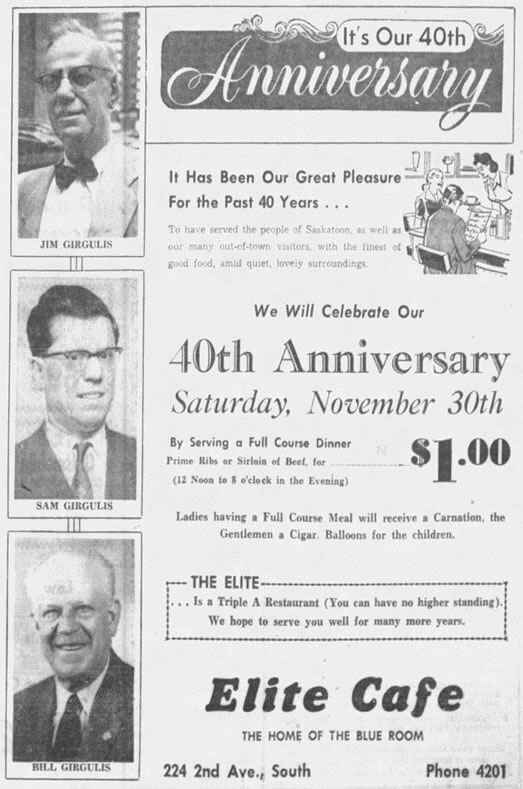
Saskatoon Star-Phoenix, November 28, 1957, p. 6.
Even though the Girgulis men have given years in service and in quality food to thousands, they appreciate the support Saskatoon and district have given them. To show their thankfulness, Jimmy Girgulis said:
“In the fall, sometime in September, we’re going to observe our fortieth anniversary in a special way by serving special prime ribs of roast dinners at $1 a plate to Saskatoon families after they’re home from holidays, and back to work and school.” This gesture by Jimmy Girgulis, the founder of the Elite, typifies the sportsmanship of a man who is as well known in trap-shooting circles as he is in the cafe business. He won the Mid-west International in Winnipeg in 1933, and Manitoba-Saskatchewan singles and doubles in trapshooting several times. He hasn’t missed a hunting season in 45 years. Besides, he also plays a “friendly” game of golf.
His formula for good eating takes you by surprise for its keynote is simplicity and quality. Thus, the man whose cafe is the only one rated Triple A in the restaurant Red Book for northern Saskatchewan recommends old fashioned breakfasts of oatmeal, and ham or bacon and eggs, with toast and coffee.
Lunch or dinner: roast prime ribs of beef. For supper, Mr. Girgulis offers beefsteak or his favorite crab fish with cocktail sauce.
“I seldom eat desserts, but my favorites are rice-raisin pudding and ice cream. I don’t believe in too many sweet things. Variety in food is the best for a person because it keeps the system tuned up,” he advises.
The Elite is famous in the West for its delicious prime ribs of beef and it’s the dish that tops Mr. Girgulis’ list, with succulent steaks a close second.
Over the 40 years, Jimmy figures they’ve served 30,000,000 meals to several million people. But they’ve taken their bumps in that time, losing $20,000 in bad debts.
Bill and Jimmy started with a modest $5,000 in 1917 and, with their youngest brother, Sammy, developed their business until the Elite has an estimated worth today of $175,000. Sammy has been associated with his brothers for almost his lifetime – for more than 30 years. Their policy of continuous remodeling gave the Blue Room a new lift four years ago. Three years earlier the counter was rebuilt.
Jimmy, who observed his 62nd birthday June 22, is a spare, active man, weighing 150 pounds. He’s five feet eight inches tall. “Look at me,” he says, “I keep in shape largely because of good eating habits.”
A native of Kastrion, 30 miles from Sparta, Jimmy left his homeland when he was 15, spent six months in Coney Island, New York, selling peanuts, popcorn, and candy for “a distant uncle.” His brother Bill had gone to Texas a year earlier, then moved up to Regina where Jimmy joined him.
“When I arrived at the old Grand Trunk station, I was wearing my straw hat, and the ground in Regina was covered with snow. Imagine that!” Jimmy exclaimed.
In Regina, he worked for his uncle Peter Girgulis at the Elite Cafe on Scarth Street, just south of the old post office. He said it was one of the finest restaurants in the West, a fact to which this writer can testify. The old mahogany fixtures now make up altar panels at Father Athol Murray’s college chapel at Notre Dame, Wilcox.
“My uncle had a headwaiter, Spero Miller, a Greek. He taught me an awful lot and when he left. there, I took over his place as head waiter,” Jimmy recalled.
He left his uncle and in August 1917 started at the old Savoy Cafe here, on Twenty-first Street, near the old post office and next to the Bijou theatre. His partners were Tom Varvas and William Scherounis. Then in 1919, he and his brother Bill bought the Elite Cafe, with Bill as manager. Jimmy sold his interest in the Savoy in 1922, joined Bill in operating the Elite where the Gem Cafe is now, and moved in 1929 to their present location. Jimmy said there was just a shack at the present Elite site, owned by Dr. P. D. Stewart. “He built a place for us, and we rented from him until his death, then bought this building from his estate,” Jimmy said.
In common with the majority of Saskatonians. Jimmy takes pride in the University of Saskatchewan which he thinks is the finest on the continent. His daughter, Christine, who is presently on the continent and visiting Greece as well, is a Saskatchewan Arts graduate of ’52, a Toronto University graduate of ‘54, and a member of this city’s library staff. His son, Billy, graduate in Law of ’55 here, is practicing in Edmonton; and his son Harry, graduate in Engineering of ’57 here is a mechanical engineer with Ford Company of Canada in Windsor.
Jimmy explains his great interest in the cafe business and sports is because he enjoys meeting people. “And always lots of people came in to see who I was when I was trapshooting,” he said.
In the long years, Jimmy has observed a great improvement in the quality of food and has experienced soaring prices, especially for greens imported from California. Besides, he imports from Montreal special grade olive oil and spices not attainable locally.
The late Sid Johns, longtime manager of the Saskatoon Exhibition board, is credited by Jimmy with being responsible for the big improvement in beef quality back in the 1930s. Mr. Johns, he said, got calf clubs started, and as a result, there was a noticeable betterment in the quality of beef.
“The farmers are the biggest trade we’ve got here. At first, we had to train people to use the cafes back in the early 1920s,” he reminisced.
“We train our cooks to our specifications, and we insist on quality. It is the cheapest in the long run in the restaurant business,” according to Jimmy. Jimmy said he thinks wines with meals are necessary, especially for the traveling public, and cocktail bars properly managed would make for greatly improved observance of the liquor laws. “They’re breaking the law now anyway,” he said.
Jimmy gives a big assist to his wife, the former Mary Ballek, for his success. This happy team has seen the Elite move to the top rank in the cafe business. They’ve served such notables as the Duke of Windsor when he was Prince of Wales in 1919, Premier T. C. Douglas, Lieutenant Gov. W. J. Patterson, Rt. Hon. Jimmy Gardiner, and of course, Canada’s new Prime Minister, John Diefenbaker.
Mr. Girgulis, a keen student of the cafe business, says, “I keep up to date. I hope I live another 10 years to have a good golden anniversary.”
Saskatoon hopes so too.
Source: Pat O’Dwyer, “On the Town”, Saskatoon Star-Phoenix, August 14, 1957, p. 12.
Granada House Restaurant
Granada House Family Restaurant and Lounge (904 – 22nd Street West)
Owners/Operators: Nikitas Kokonas, Alex Liakopoulos, Bill Kondos, and George Kondos (1980 – 1993); Nikitas Kokonas, Alex Liakopoulos, George Kondos, and Evangelia Kondos ( 1993 – 1994); Alex Liakopoulos, George Kondos, and Evangelia Kondos (1994 – 1997); Alex and Shirley Liakopoulos (1997 – 2021)
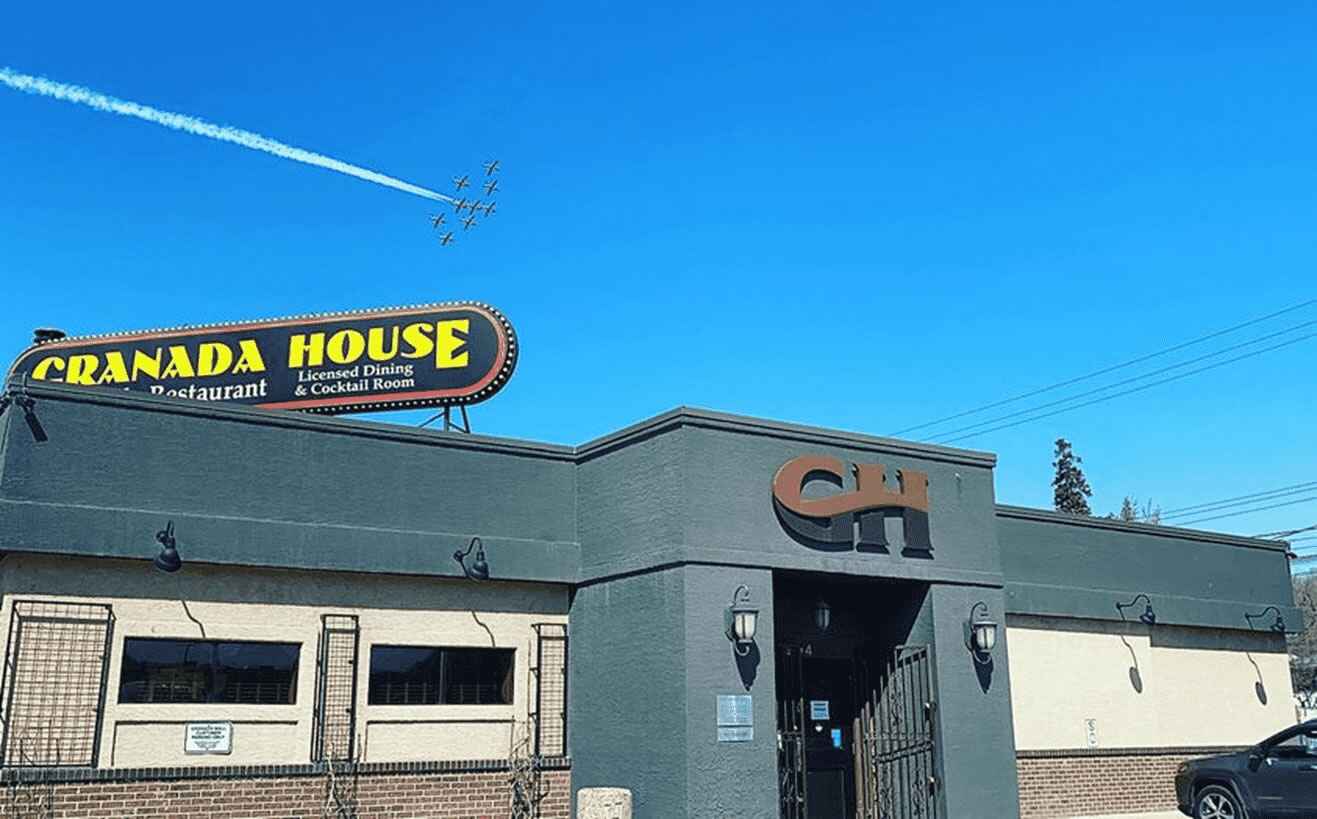 Source: Granda House Restaurant and Lounge, Facebook, May 14, 2020.
Source: Granda House Restaurant and Lounge, Facebook, May 14, 2020.
In 1980, Nikitas (Nick) Kokonas and Alex Liakopoulos sold their interest in the Commodore Café and entered into partnership with Bill Kondos and George Kondos in the Granada House Restaurant.
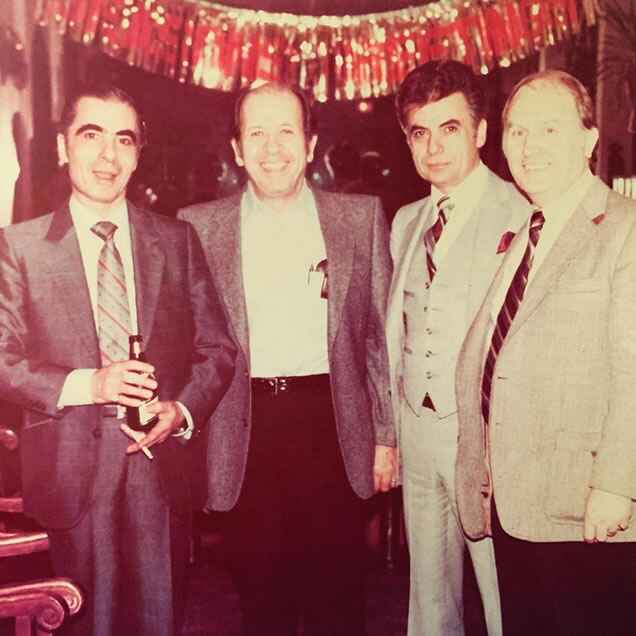
Granada House Restaurant and Lounge – Original Owners (not dated)
Left to Right: George Kondos, Nikitas Kokonas, Bill Kondos, and Alex Liakopoulos
Source: Granada House Restaurant and Lounge
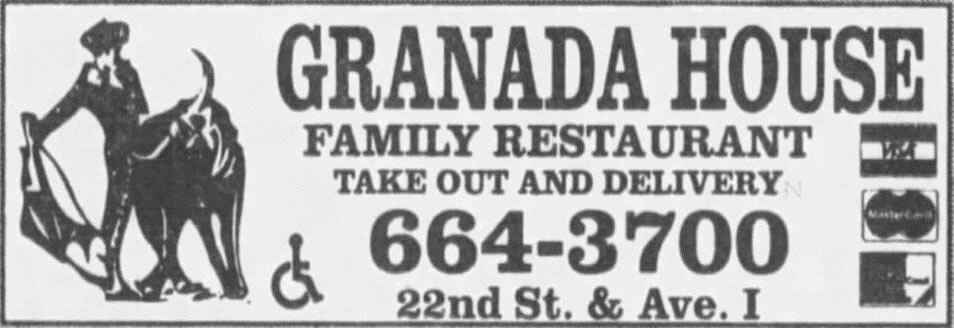
Source: Saskatoon Star-Phoenix, April 2, 1993, p. 51
When Bill Kondos passed away in 1993, his wife, Evangela Kondos, took over his partnership. Nikita Kokonas retired in 1994. George Kondos and Evangela Kondos retired in 1997.
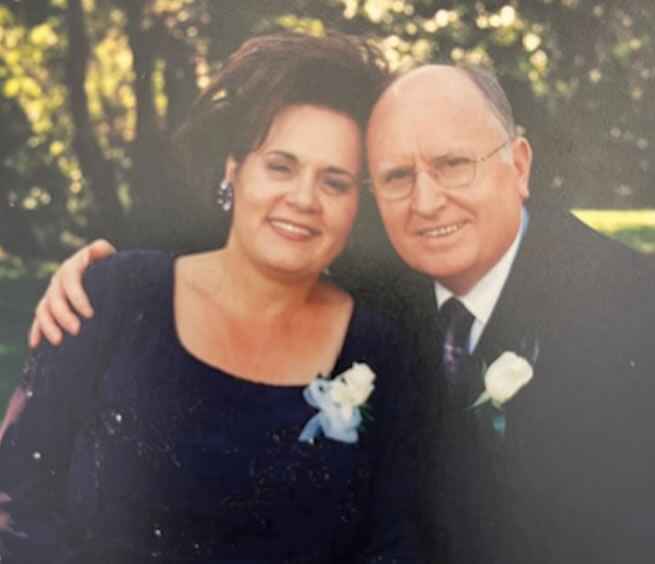
Alex and Shirley Liakopoulos
Source: Tony Antonopoulos
When the business celebrated its 20th anniversary in 2020, the Granada House was owned and managed by Alex and Shirley Liakopoulos. In a newspaper article about the 20th anniversary, Alex said:
“Granada has survived for so long because of the quality of the food and the service we provide to people. We always have and always will treat customers as if they are our friends and family. We certainly appreciate the support we receive from all our customers, not only the ones from Saskatoon, but the man outside the city who visit us on a regular basis.”
At that time, the restaurant could seat 167 customers and the lounge could accommodate up to 50 people.

A “wall of fame” in the Granada House contained photographs of personalities who had visited the restaurant, including singers Celine Dion, Leona Boyd, Nana Mouskouri, and Marie Osmond and hockey player Eddie Shack. However, the photo that gained the greatest attention was the Liakopoulos family’s tribute to Saskatonian George Adilman, a well-known and colourful personality who lived in the city from 1928 until he died in 2000.
Check out Granada House’s great menu…
Johnny's Lunch
Johnny’s Lunch
351 Second Avenue South
Owners/Operators: John P. Pontikes and Peter K. Pontikes (1953 – 1956)
(Source: Pontikes Family Video – Screen Shot)
In 1953, cousins John P. Pontikes and Peter K. Pontikes purchased the Log Cabin Inn, a 23-stool lunch counter located at 351 Second Avenue South in Saskatoon. Isaac Brown and James Forsyth had owned the business. The business’s name was changed to Johnny’s Lunch.
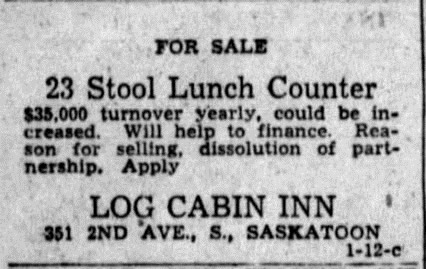
Source: Saskatoon Star-Phoenix, January 10, 1953, p. 21.
Johnny’s Lunch occupied a portion of the main floor of a two-story building owned by local auto dealer, Automobile Clearing House Ltd. The lease provided access, by an interior staircase, to washroom facilities on the second floor.
Several family members recently arrived from Greece, and worked at Johnny’s Lunch. They included Kiki Pontikes (John’s sister) and John Pappas (uncle to Peter’s wife).
On July 8, 1956, an early Sunday-morning fire extensively damaged the building’s roof and interior stairs. By the time firefighters arrived, flames were visible on the roof and thick black smoke engulfed the immediate area. To prevent the fire from spreading (particularly to a nearby auto paint shop), fire hoses were inserted into holes chopped into each side of the roof. Johnny’s Lunch, below on the main floor, suffered smoke and water damage.
Peter and John were forced to close Johnny’s Lunch from July 8 to July 15. On July 16, they managed to reopen their business “in a limited manner”. However, City inspectors declared the building as “hazardous” and ordered the owner (Automobile Clearing House) to repair the roof or take “some similar action”. In August, the owner informed Peter and John that instead of repairing the roof, the building would be demolished, and their lease would be terminated. Johnny’s Lunch continued operating until September 30, after which the demolition was scheduled to proceed. Peter and John sought a court injunction to give them time to obtain a court order to force the owner to maintain the lease by repairing, rather than demolishing, the building. With the demolition on hold, a judge heard the injunction application on October 29, 1956, and decided the next day, to tear it down. The lease was terminated, and the building was demolished.
Researched by Ken Pontikes, October 4, 2023
Sources: Saskatoon Star-Phoenix, July 9, 1956, p. 2 and October 29, 1956, p. 3; Henderson’s Greater Saskatoon Directory, 1953 (Winnipeg: Henderson Directories Limited, 1953), p. 417.
Paragon Cafe
Paragon Café
157 Second Avenue South
Owners/Operators: Tom and Chris Kortes
In 1934, the New Patricia Café (located at 157 Second Avenue South) was sold by the Barootes family to the Kortes family. The latter operated the business under the name, “Paragon Café”. In 1953, the Paragon was closed.

Saskatoon Star-Phoenix, March 29, 1934, p. 9
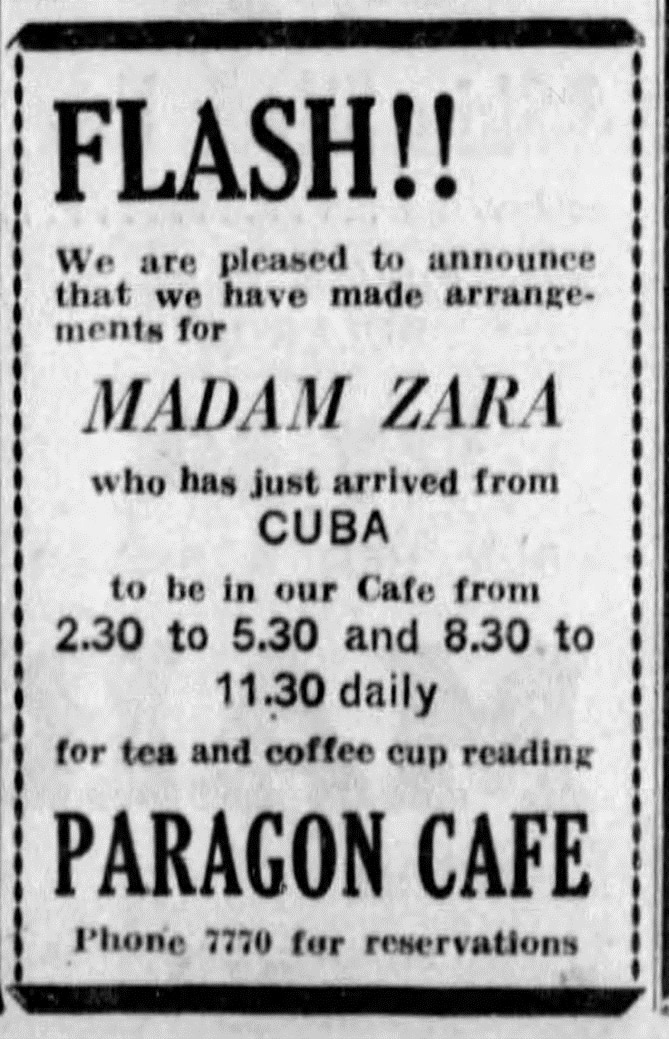
Saskatoon Star-Phoenix, December 8, 1939, p. 9.
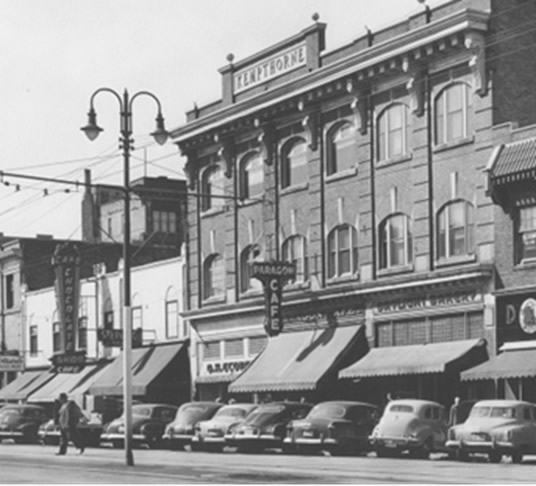
Paragon Café, located north of Golf’s Chocolate Shop and Café (1951)
Source: Saskatoon Public Library, Local History Room (B-4239)
Researched by Ken Pontikes (October 31, 2023).
Paris Cafe
Paris Café/New Paris Café and Paris Hotel
252 Second Avenue South
Owners/Operators:
- 1920 – 1924: Thomas L. Michas
- 1924 – 1932: Thomas Marines and Sam Sinis
- 1932 – 1935: Thomas Marines
- 1935 – 1940: Thomas Manos and Thomas D. Smith
- 1940 – 1944: Thomas Manos
- 1944 – 1947: Paul Kortes, Arthur Kranias, and Chris Saks
In 1920, the Michas family purchased the Gordon & Sparling Block, in which the Café was located and renamed the building as the Paris Café Block. When it opened, the Café operated 24 hours a day. The upper floors were renovated to serve as residences.
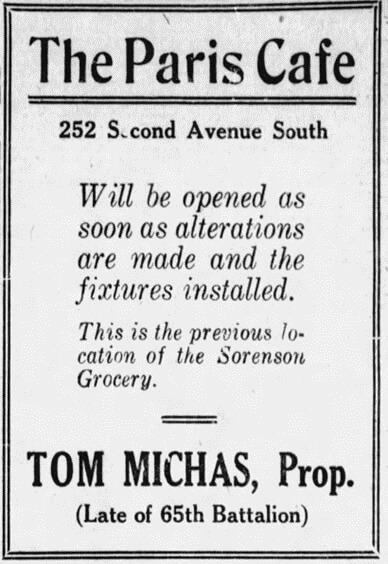
Source: Saskatoon Phoenix, January 3, 1920, p. 12
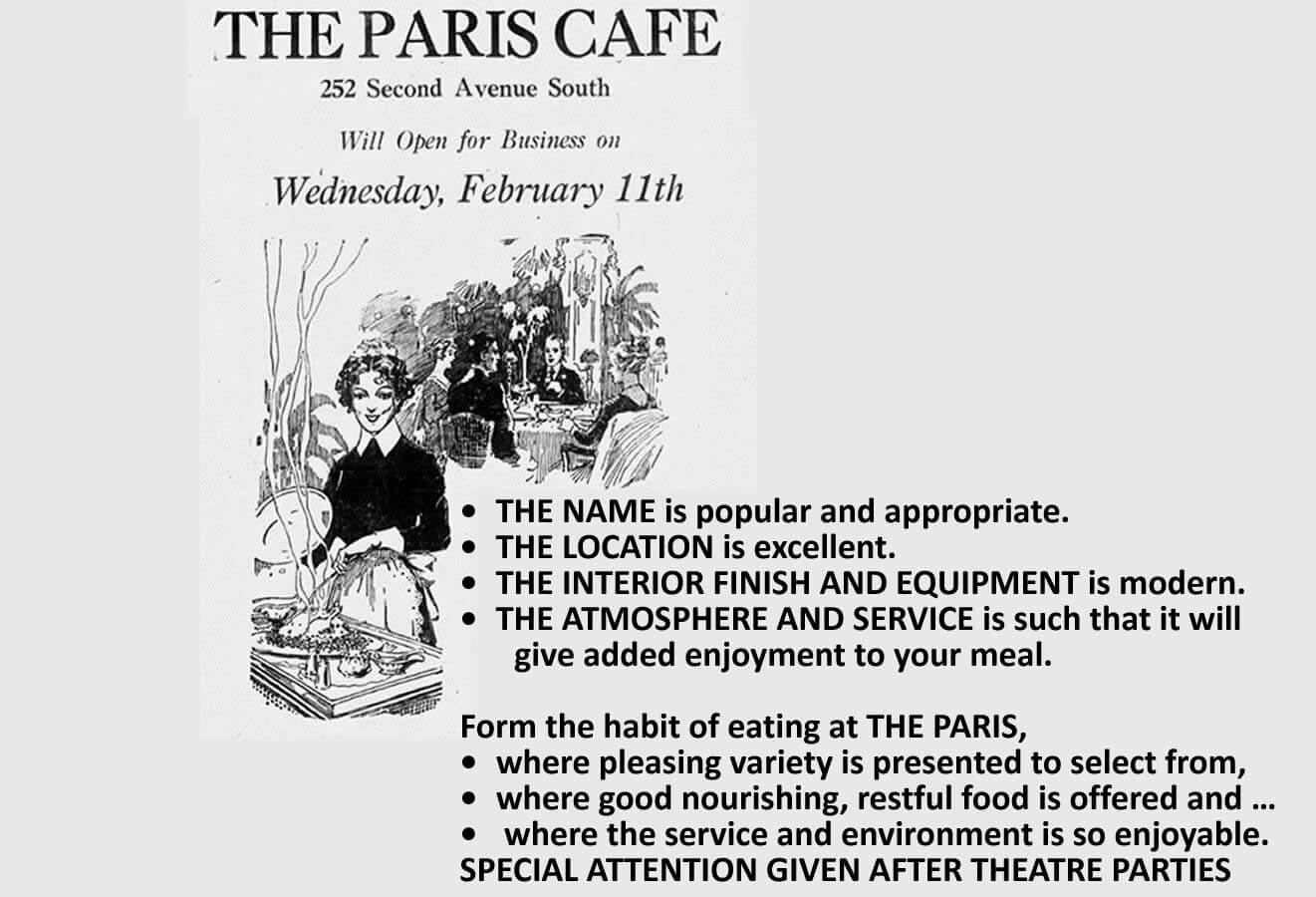
Source: Saskatoon Daily Star, February 10, 1920, p. 15.
Paris Café, 1920
Source: Saskatoon Public Library, Local History Room (PH-89-203-1)
About 1924, Mr. Michas sold his interests in the Paris Café to Sam Sinis (his nephew) and to Thomas Marines; both men previously worked at this Café before purchasing it. Mr. Michas moved to Florida.
Sam and Thomas renovated the café in 1930. The Star-Phoenix described the café’s new décor in the following quotation from the June 7, 1930 edition:
“The pleasing front of the café has been made even mor attractive with new artistic signs, the woodwork has been done in bronze effect and the tiles have added to the appearance. Within the restaurant a new color scheme has been caried out both along the big lunch counter with its gleaming and spotless bar, and the dining room, divided into booths.
The woodwork is done in a soft yellow effect with tasteful green trimming while the panels are in a mauve effect. Costly new curtains have appeared, these blending with the color scheme. The bar behind the lunch counter, with its freight of dainties and gleaming glasswork, reflected in the large mirrors, has been colored in black and yellow. The mirrors are set between pillars of imitation marble with guilt scroll work.
New equipment has also made its appearance. The attractive new soda fountain, in black and white with a white marble serving counter, is the latest thing of its kind, with the most sanitary and convenient appliances invented. Back of the dining booths is the ladies’ washroom and lavatory. Passing through to spacious and orderly kitchen one goes beyond to the big Frigidaire room, where all the fresh meats and fish and vegetables are kept fresh and sweet even in the hottest weather.”
Paris Café, Street View, 1929
Source: Saskatoon Public Library, Local History Room (PH-2016-200)
Sam and Thomas renovated the café in 1930. The Star-Phoenix described the café’s new décor in the following quotation from the June 7, 1930 edition:
“The pleasing front of the café has been made even mor attractive with new artistic signs, the woodwork has been done in bronze effect and the tiles have added to the appearance. Within the restaurant a new color scheme has been caried out both along the big lunch counter with its gleaming and spotless bar, and the dining room, divided into booths.
The woodwork is done in a soft yellow effect with tasteful green trimming while the panels are in a mauve effect. Costly new curtains have appeared, these blending with the color scheme. The bar behind the lunch counter, with its freight of dainties and gleaming glasswork, reflected in the large mirrors, has been colored in black and yellow. The mirrors are set between pillars of imitation marble with guilt scroll work.
New equipment has also made its appearance. The attractive new soda fountain, in black and white with a white marble serving counter, is the latest thing of its kind, with the most sanitary and convenient appliances invented. Back of the dining booths is the ladies’ washroom and lavatory. Passing through to spacious and orderly kitchen one goes beyond to the big Frigidaire room, where all the fresh meats and fish and vegetables are kept fresh and sweet even in the hottest weather.”
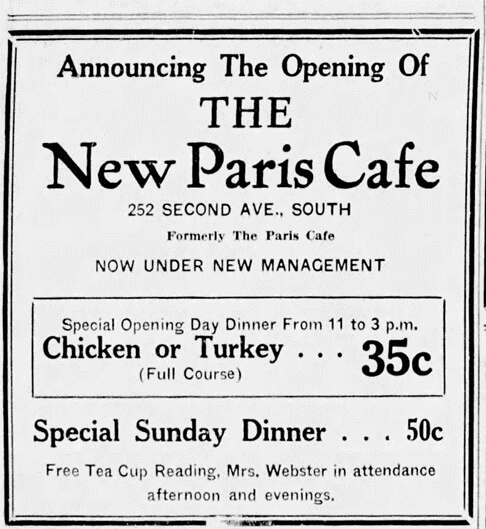 Source: Saskatoon Star-Phoenix, June 24, 1932, p. 16.
Source: Saskatoon Star-Phoenix, June 24, 1932, p. 16.
In 1932, Mr. Marines became the sole owner of the renamed, New Paris Café. He continued his ownership interest in the Paris Cafe until 1935 when he moved and entered the restaurant industry in Quebec City. By that time, the owners had converted their ownership of the building (“Paris Block”) into the Paris Cafe and Paris Hotel. The hotel and cafe were purchased by Thomas Manos and Thomas D. Smith. Before coming to Saskatoon, Mr. Smith was the owner and operator of a business in Moose Jaw which was also named, the Paris Café and Paris Hotel.
THE NEW PARIS CAFE
Reopens Tomorrow at 11 a.m.
UNDER NEW MANAGEMENT
TOM. D. SMITH, Manager; TOM MANOS, Assistant Manager
EVERYTHING about the New Paris Cafe is–as our name
correctly designates it entirely NEW. You’ll be amazed at the changes we have accomplished seating, new counters, new booths entirely new layout, new equipment installed everything that could make a restaurant that is home-like, and convenient. And most important of all, here’s where the food you get and the company you find are equally desirable.
The new management, with a lifetime of experience in catering to the food requirements of a discriminating public, 24 years of it spent in Regina, Moose Jaw, and Saskatoon, have particularly selected their staff with a service eye. We firmly believe that if you had a chef at home, you couldn’t get better cooking or service than that which awaits you at the New Paris Cafe.
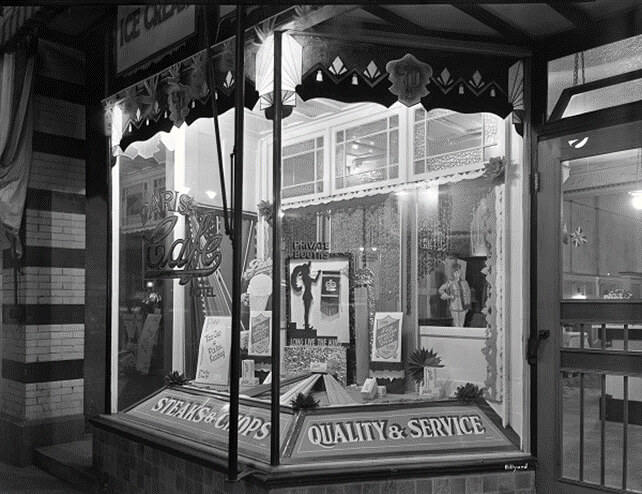
Paris Café, Front Window Display, 1937
Source: Saskatoon Public Library, Local History Room (A-1022)
By 1940, Mr. Manos became the sole owner of the building and the cafe-hotel business. Paul Kortes, Arthur Kranias, and Chris Saks purchased the Paris Cafe in the mid-1940s. They continued to operate the businesses until 1947 when they sold them to “non-Greek” operators.
Researched by Ken Pontikes, July 31, 2023
Sources: Saskatoon Pheonix and Star-Phoenix: various issues; Saskatoon Daily Star: various issues.
Patricia Cafe
Patricia Confectionery and Tea Room (“The Patricia”) (1914 – 1926)
New Patricia Café (1926 – 1933)
265 Second Avenue South and 157 Second Avenue South
Owners/Operators: Barootes (Efthemios) Family: Vasilis (Basil), Nicholas, Christos, and Theopani (Stephen)
Vassili Barootes arrived in Canada from Triglia in Asia Minor in 1903 at the age of seventeen. In Toronto, he learned to make candies and chocolates. Shortly afterward, he and his brothers – Christos, Theopani, Nicholas, Vassili’s wife, Anastisia moved to Winnipeg where they operated the Alberta Café on the corner of Portage and Garry.
Source: Winnipeg Tribune, October 19, 1907, p. 10
In 1914, the Barootes family opened the Patricia Confectionary and Tea Rooms (also known as “The Patricia”) in Saskatoon. Located at 265 Second Avenue South, the business sold home-made candies, chocolates, and luncheon items. Members of the Barootes family moved to Saskatoon to operate their business interests in this city.
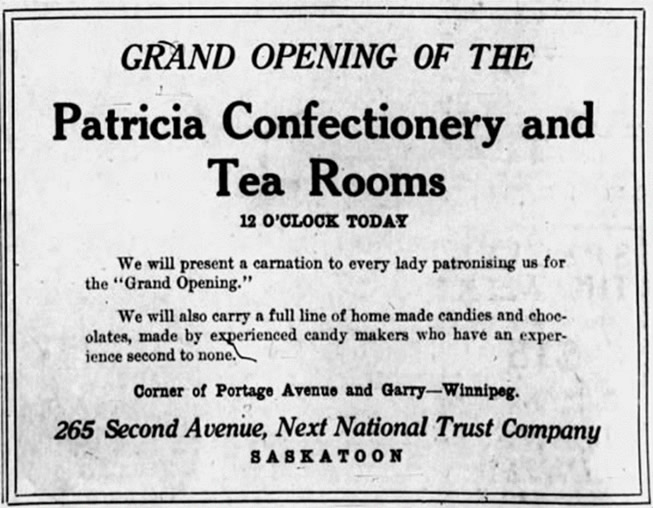 Source: Saskatoon Daily Star, November 16, 1914, p 12.
Source: Saskatoon Daily Star, November 16, 1914, p 12.
Source: Saskatoon Daily Star, December 20, 1915, p. 8.
By 1918, the business expanded to include a candy counter, a soda fountain, and ice cream parlour, as well as a candy factory in the rear of the building.
Source: Saskatoon Daily Star, February 28, 1918, p. 14.
Patricia Café, 1921
Source: Saskatoon’s Greek Community – The Pioneers, 1901 – 1949
Renovations in 1926 reconfigured the business into a restaurant, now known as the New Patricia Café, which continued to sell chocolates and other candies.
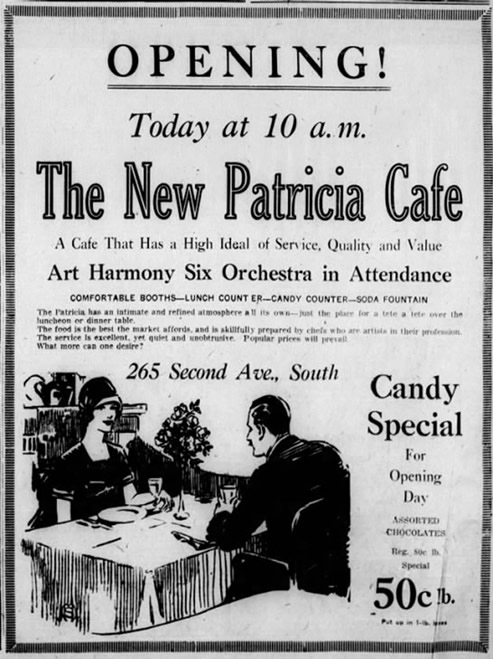 Source: Saskatoon Star-Phoenix, March 22, 1926, p. 10
Source: Saskatoon Star-Phoenix, March 22, 1926, p. 10
New Patricia Café (1928)
Source: Saskatoon Public Library, Local History Room (LH-6284)
In 1933, the New Patricia Café relocated to 157 Second Avenue South. The space at 265 Second Avenue South was occupied by the National Lunch (a business that was not operated by a Greek family) and by the Saskatoon Co-operative Association Limited.
The New Patricia Café was sold in 1934 to the Kortes family who operated the business under the name, “Paragon Café”. In 1942, the Paragon was closed.
Researched by Ken Pontikes (October 31, 2023).
Princess Cafe
Princess Cafe
109 Twentieth Street West (1926 – 1931)
Owners/Operators: Nicholas J. Pappas and Andrew Peters
The Princess Café was purchased by Nick Pappas and Andy Peters in November 1926 from Fred Quong, Alex Quong, and Quong Lung Gam. Andy was a well-known local Greek chef and performed this role at the Princess Café. Renovations of the café were completed in March of 192
Saskatoon Star-Phoenix, March 3, 1928, p. 24
Saskatoon Star-Phoenix, June 28, 1928, p. 15.
Nick and Andy operated the café until 1931. At that time, the café was closed and the space was offered for rent.
Researched by Ken Pontikes, January 11, 2024.
Saskatoon Station Place
Saskatoon Station Place
221 Idlywyld Drive North
Owners/Operators (1985 – 2019): Chris, Dave, John, and Stavros Arvanitis
Source: Saskatoon Star-Phoenix, November 12, 1994, p. 45
Brothers are not above washing dishes…
The Brothers Arvanitis started immigrant life in Canada by washing dishes. Sometimes John, Dave, Chris, and Stavros-owners of arguably the most distinctive restaurant in town- still wash dishes.
“Success is paying attention to detail. If a job has to be done, don’t quarrel about who should be doing it, do it,” says Dave Arvanitis, 49, one of the four brothers who originated the Saskatoon Station Place restaurant. Bankers will tell you that almost every budding entrepreneur in town thinks first of opening a restaurant. They’ll also tell you the worst people to loan money to are chefs and maitre d’s with a great idea for a new eatery. Eight out of 10 restaurants open and close almost before the appetizer and soup are served.
“You have to know this business from the ground up,” says John Arvanitis, 58, the first brother to cross the sea from Greece to Canada, “and you have to know every single phase of it. There are hundreds of restaurants in Saskatoon. If you’re not prepared to offer something absolutely different, why would guests leave one restaurant for your restaurant?”
The Saskatoon Station Place is different. Just last month a visitor walked into it and asked when the next tour was. She actually thought it was a real 1880s train and train station combined. That’s exactly the touch the Arvanitis brothers wanted for their restaurant, and it’s why they employed a Toronto antique dealer to scour the world looking for railroad artifacts and memorabilia from the turn of the century.
The Arvanitis Brothers spent six years planning their restaurant, another year pondering architectural designs, and one-year watching construction come together before their five-room, 300-guest eatery on Idylwyld Drive and 23rd Street became a reality. That, plus a proven track record, was enough to convince the bank.
“The reason most people fail in business is that they don’t really know what they’re getting into, and they haven’t planned it,” says Dave. “You have to find a need or develop one.
The four brothers came over from Greece one at a time between 1958 and 1964. Unable to speak English. They all started off washing dishes, graduated to becoming waiters, and then chefs, and learned everything they could about restaurants.
In 1968, with a few thousand dollars saved, they bought the old Shasta coffee shop on Second Avenue. They spruced it up, and within a few months, it was paying their way. In 1972, they bought the building and changed the Shasta into the A-Four supper club, A-Four standing for Arvanitis Four. Like the Shasta, it was a success from day one. Although after embarking on The Station Place project they closed the A-Four, they and a partner just last month reopened it.
“We put everything we had into it,” says Dave, “and took nothing out. “Too many people think profit, profit, profit. The customer doesn’t think of profits, they think of the best possible deal at the best possible price. You can charge someone $15 for an entree, and then add $5 for an appetizer, $4 for salad, and $3 for a soup, but are they ever going to come back again? Even if they can afford that once a year, they’ll remember it when the economy tightens. I’d rather give them an appetizer, salad, and soup for free, and make sure they remember it.”
The brothers say they realized if they ever wanted to establish a landmark restaurant in Saskatoon it would have to be something really different.
“We’d heard of restaurants on boats, and restaurants designed like boats, and even a restaurant shaped like an airplane. We knew that was the way to go. Initially, we intended to build our restaurant on Eighth Street, but when the land adjacent to the old CPR station became vacant the choice was obvious, ” explains Starvos, 43.
“There were certainly some advantages aside from the obvious. From operating the A-Four we knew that parking space could make or break a restaurant. It’s points like parking that, if overlooked, can doom your business. In this location, we have parking for almost 200 cars. Let’s face it, whoever heard of a train station without lots of parking?”
Even so, there were worries before opening. Costs mushroomed as elegance increased. The club car and the dining car were built on real locomotive platforms, with no margin for error in design or construction. Railroad artifacts had to be fascinating, but not overbearing. The huge wooden carved bar finally needed a special crew of men flown in from Toronto to erect.
“When you have 80 to 100 employees you have other worries. You feel responsible for their well-being. Some have given up other jobs to join you, some have families to support. You realize if you make a mistake, they suffer.”
“We had to price items for everyone’s pocket. If you want to spend $50 or more for a night out, fine. But if you’ve only got $10 or $20, that’s fine too. We’d rather be full, than empty.”
As it happened, no one suffered.
“The day we opened up in 1983 we were full. We couldn’t believe it. People were lined up just like passengers for a train,” says Stavros.
The brothers’ insistence that success is learning the business from the ground up has been instilled in a second generation. George, the 24-year-old son of John. is now a bartender, but for years he earned his allowance washing dishes at 50 cents an hour.
“I never had it easy, but what successful people do?” says the younger Arvanitis, philosophically.
Saskatoon Star-Phoenix, September 3, 1988, p. 77.
Source: Saskatoon Star-Phoenix, January 26, 1996, p. 52.
While passenger rail travel these days is but an echo of its one-time glory, the Arvanitis brothers continue to keep Saskatoon on track with their delightful Saskatoon Station Place Restaurant.
Dave, Stavros, Chris, and John opened their popular dining spot on Idylwyld Drive back in 1964. The planning and building took a huge investment in cash and time, but it was a labor of love for the four transplanted Greek restaurateurs. Their unique architectural achievement has become an integral part of Saskatoon’s culinary landscape.
Painstakingly recreated Pullman carriages anchor the restaurant’s design, and the theme of turn-of-the-century passenger rail transportation flows throughout the 300-seat dining spot The combined visual effects of expensive antiques, authentic first-class CN furnishings, stained glass leaded windows and the solid walnut and oak inlaid tables contribute to the anticipation of a wonderful dining experience.
The Station’s passengers are not to be disappointed thanks to the Arvanitis kitchen, which possesses all the skills needed to serve consistently quality cuisine. That’s good. I figure that, if the elegant surroundings uplift the mood of diners, it only serves to prepare them for the real reason that they came.
Specializing in prime rib, steaks, gourmet chicken dinners, seafood, Greek ribs, and souvlaki meals, Saskatoon Station Place holds its biggest surprise for first-time visitors by having reasonable prices. Despite the expensive decor and artwork, a glance at the menu prices shows why the restaurant attracts a wide audience. Dishes like Filet of Sole ($10.99)- lightly breaded and sauteed in lemon- butter and sprinkled with baked almonds, and Barbecued Spareribs ($13.90) – a slab of tender ribs, broiled with the Station’s special sauce. Like most other entrees, soup, salad, veggie, and your choice of potato or rice are included.
There’s also a selection of pasta dishes including Fettuccine Alfredo ($9.99) -served with garlic toast, and Lasage ($8.49)-with meat sauce and garlic toast.
Famous for the prime rib, which is so tender you really can cut it with a fork, the Station offers a couple of different sizes ($14.90 and $18.99) -again all-inclusive of salad, soup, etc. Steaks are also a popular item, such as the 8 or New York ($13.99) 10 oz. Filet Mignon ($18.99) or the whopping 16 oz T-bone ($16.99)-all are selected from aged cuts of beef and served with sauteed mushrooms.
The gourmet chicken dishes on the menu include Chicken Breast Swiss ($14.99) – a boneless breast of chicken, topped with bacon and melted Swiss cheese and served with mushroom sauce; and my particular favorite, Chicken and Spinach ($14.99) – a boneless breast of chicken, stuffed with spinach, feta cheese, and fresh herbs and splashed with the house specialty lemon-sauce.
If you’re out for a night on the town or you have a big appetite, you might want to check out the list of combo meals offered here under the appropriate title. Couplings. There’s Chicken and Ribs ($17.99), Chicken and Shrimp Scampi ($17.99) Filet Mignon and Lobster Tail ($27.99), and Greek Ribs and Shrimp Scampi ($17.90)
For those with lighter things on their mind, salads abound, including Greek ($7.49), Caesar ($6.99), Shrimp salad ($8.99), and Warm Chicken Salad ($8.99) – broiled chicken breast slices on top of Caesar salad.
As you might expect, you’ll find a variety of souvlaki to choose from, such as Pork ($11.99), chicken ($12.99), or lamb ($13.99) all marinated in special sauces these dishes come with two Souvlakis, soup, salad veggie and a choice of potato. Besides regular menu listings, every evening has a variety of different specials to attract your attention. There’s an inexpensive lunch menu served until 3.30 pm, featuring homemade hamburgers and fries, from $5.45 to $6.45, omelettes, croissants, soups, salads, and sandwiches. The extensive Sunday brunch has also proved a popular addition to the Saskatoon Station Place’s dining activities.
A good wine list, with more than 50 labels, adds to the dining enjoyment.
With more than 30 successful years in the Saskatoon restaurant business, these brothers know just how to turn on the appetites of their customers. John Arvanitis holds the main responsibility for the kitchen production, but Dave is no slouch when it comes to food preparation. When he’s not out mixing with customers, you’ll find this partner mixing his bread dough. His bread rolls are baked fresh daily and are a classy complement to any good meal.
Carrying a huge tray of hot out of the oven bread rolls, Dave, his suit jacket temporarily removed and replaced with a white baker’s smock holds out the still steaming rolls for inspection.
“Try one, tell me if it’s like the bread you had when you visited Greece,” the amiable Dave enquires.
Layering on butter, which melts on contact with the hot bread. I chew off a chunk from the bun. I tell him that the taste takes me back to the wonders of romantic, historical Athens. Dave is pleased.
Stavros pours wine, a fine Boutari red. The two brothers clink their glasses with mine and toast to my health. My glass is refilled and another toast, this time to the friends and customers that have filled the restaurant over the years.
More bread, some delicious appetizers, and quickly the warmth of that Mediterranean feeling washes over the soul as the two brothers talk of food and wine with obvious passion, a passion shared by their customers.
“We have so many loyal customers that visit us, customers that have become friends,” says Stavros. “We spend so much time in this place it’s home for us, and home is where you serve your very best to your guests, “he says. Judging by the long-term success of their restaurant, I’d say the Arvanitis brothers have developed many lasting friendships.
Editor’s Note: The Saskatoon Station Place closed in June 2019. The following year, the Old Spaghetti Factory opened in the building and continued to display many of the antiques that had been collected for the former businesses by the Arvanitis family.
The Saskatoon Station Place has been a landmark in a prime location on Idylwyld Drive since the 1980s. Ahead of its permanent closure on June 27, the StarPhoenix spoke with co-owner Stavros Arvanitis about some of the staple items on the menu over the years – so make sure to try them all while there is time, writes Alexa Lawlor.
Stavros Arvanitis, co-owner of the Saskatoon Station Place, sits in his historic Station Place restaurant.
KAYLE NEIS: STATION PLACE MENU STAPLES SASKATOON WILL MISS
- The Pullman’s Platter comes with 3 appetizers: spanakopita, or a spinach pie; youvarlakia, fresh ground beef, rice, and spic- es topped with a lemon sauce; and dolmathakia, vine leaves filled with rice, ground meat, and topped with a lemon sauce, alongside three entrees: shrimp scampi, Greek ribs, and a boneless breaded chicken breast. It’s topped off with a choice of soup or salad as well.
- Arvanitis says the steaks are also a classic menu staple at the Station Place. From filet mignon. to New York strip steaks and rib eyes, there’s an option for everyone.
- Prime Rib – The secret to the Station Place’s prime rib, according to Arvanitis, is in the slow roasting process. He says leaving the prime rib overnight is key to making it great. The Station Place offers a prime rib sandwich on the lunch menu, which is a 6 oz. cut, or a 10 or 12 oz. cut on the dinner menu.
- Greek Ribs – Prepared with lemon and garlic butter, Arvanitis says the Greek ribs are yet another classic staple on the Station Place menu.
- The Station Place offers a buffet brunch on Sundays from 10 a.m. to 2 p.m. Guests can choose from a variety of appetizers, hot dishes, meat carvings, and various choices of fruits and desserts. “When they give you a comment but don’t come back it’s an issue, but for the brunch, they give a comment and they come back – that means you’ve done a good job,” Arvanitis said. Even now, with the closure, Arvanitis says they’ve been getting overwhelming support, with people coming into the restaurant to give hugs, kisses, and to share memories.
The Beautiful Staircase
The Dining Car.
The Lounge Dining Car
2nd Floor View
The Bar
The Wine Cellar
Suburban Restaurant
Suburban Restaurant
Avenue A (Idylwyld Drive) North, Highway 11 North
Owners/Operators: Peter Bezbes, James Kosmas,Peter Pontikes (1959 – 1973)
Suburban Restaurant, 1964
Source: Saskatoon Public Library, Local History Room (QC-2843-2)
Personal Memories: Ken Peter Pontikes, Saskatoon
In 1959, my dad with his partners (James Kosmas and Peter Bezbes) took a huge gamble and built a restaurant (consisting of a coffee shop, formal dining room, banquet room, and curb service) on land located outside of Saskatoon’s city limits and north of the airport. It was far enough from the city to rely on on-site wells for its supply of water and in sewage lagoons in a remoter corner of the property. (Later, the surrounding property was developed into a “recreation centre” including a Par 3 golf course.) The business, known as the Suburban Restaurant, was in addition to an existing successful operation, the Barry Café, which was in the Riversdale business district.
Don Keeler Orchestra (1959)
Left to Right: Harold Smith (sax), Charlie Gentle (trumpet), Doug Stock (sax), George Russell (sax), Don Keeler (drums), John Diduck (bass), Harry Smith (piano)
Saskatoon Public Library, Local History Room (PH-91-48-13)
Every Saturday night, the Suburban operated a dine-and-dance “supper club”. Don Keeler’s orchestra provided the live music and CKOM Radio broadcast a half hour of the “live” music (recorded for broadcast the following week) from the Suburban. The restaurant was not licensed for liquor (which is another story) and customers occasionally brought in hipflasks to spike their soft drinks – fortunately, the police never raided the event.
The Barry Café was closed on Saturday nights and all owners and staff were at the Suburban for the supper club. Tickets were sold in advance and my mother would serve as the hostess who greeted the customers and escorted them to their pre-assigned tables in the banquet room.
My sister (Diane) and I remained at home on Saturday nights, most often without a sitter. (In 1961, we were aged 12 and 7.) We would get lots of “check-in” calls to see how we were and if we could stay awake until after 1:00 a.m., early morning snacks would be brought home for us to eat. As a special treat, my parents occasionally would stop at the Golden Dragon Restaurant for take-out Chinese food.
Advertisement for 1961 New Year’s Eve at the Suburban; dancing could not legally begin until after midnight because New Year’s Eve was on a Sunday.
Saskatoon Star-Phoenix, December 30, 1961, p. 4.
New Year’s Eve was a special night for Diane and me. Since the last customers at the special supper club event (known as the “New Year’s Eve Frolic) didn’t leave until after 2:00 a.m., my parents brought us to the Suburban to participate in the festivities and observe how adults celebrated the new year. (Our assessment as children was there was too much hugging and kissing at midnight — particularly when it involved us!) Our job at the Suburban on New Year’s Eve was to operate the coat check. Often, the coats, particularly the fur coats, were very heavy and we would both carry them behind a wall to the back room where they would end up on the floor before being placed on hangers. We issued claim tickets for quick retrieval of the coats at the end of the event. The best part of the evening was that Diane and I were given the tips from a dish placed on the coat-check counter. We also joined in the staff dinner at the end of the event.
Diane and I operated the coat check for a few years and regular customers came to know us from one year to the next. They often commented on how we had grown over the previous twelve months.
Source: Ken Peter Pontikes, Facebook, December 30, 2023
